Work Style
A worldwide observatory on work style changes
Truth in information by Erik Wachtmeister 08 CEOs show true colors by Del Jones 10 Avoiding solitude by Alan Vaux 15 Data protection is freedom by Rosario Imperiali 16 Effects of downsizing by Karen and Aneil Mishra 24 I reward you without money by Ruy Shiozawa 27 A dreamer in the realm of HD by Pina Draskovich 28 The US Government’s ideas by Matthew Seminara 39 The ‘review culture’ by Paolo Valentino 42 Nyc: The city that never stops by Scott Michels 47 São Paulo The financial hub of Brazil by Bahar Puraligil 52 Polluted cities: The cost of doing business by Sachin Joshi 58 Furniture: Simplicity & sustainability by Milan Lee 60 The stylish workplace: Aesthetics and happiness by Fabian Uzaraga 63


#03 The work style magazine — # 3.2010 — Europe 10 ¤, World 18 ¤ — Poste Italiane - Spedizione in abbonamento postale - 70% - LO/MI
Colophon
# 3 issue, April 2010
International publisher
Pe Partecipazioni editorali
Via GB Pioda 5, POBox, 6901 Lugano, Switzerland
T 0041 91 9101000
W www.theworkstylemagazine.com E welcome@theworkstylemagazine.com
Italian publisher
Gds Brand consultancy

Foro Buonaparte 48, 20121 Milan, Italy
T 0039 02 80583151
Printing Italgrafica
Via Verbano 146, 28100 Novara, Italy Periodical
Chairman Mirko Nesurini
Editor in Chief Giorgio Tedeschi
Editor Paola Bettinelli
Foreign Editors Pina Draskovich, Fabian Uzaraga
Section Editors Filippo De Bortoli, Luca Brunoni, Pia Colombo, Milan Lee, Nigel Phillips, Sara Peverelli, Bahar Puraligil
Advertising Raquel Mendez
Cover illustration Hanna Melin
Authors’ illustrator Alessandro Baronciani
Subscriptions
Roberta Donati
Summary
16
Silence is not always golden Data protection is freedom
Data privacy is what allows each of us to maintain our dignity in our private lives, just as occurs in the workplace.
17
It’s time for the sturdy sailors Sliding competencies
The saying ‘when the going gets tough, the tough get going’ has never been more relevant than in these hard times of recession and uncertainty.
18 Cooking as Team Building Getting a taste for training
Design evolution The workplace of the future
It’s only too easy to exaggerate our appetite for change, whereas in fact our human instincts simultaneously embrace the new, whilst clinging resolutely to the known.
Managing a company and making decisions while cooking are now parallel universes. 21
Video Learning Training video comes of age
The original grainy videos have been replaced by recognizable (soap) actors in slickly produced DVDs and multimedia platforms.
23
Mentoring Reinventing oneself
15
Dangerous changes
Today the age doesn’t matter anymore; it’s the experience and knowledge that count. 24
visit: www.theworkstylemagazine.com
To
Avoiding solitude
The best advice for being happy in unknown places when moving to another city for work is to establish new habits and identify places to go to.
‘Head chopper’ specialists Effects of downsizing
Using effective downsizing strategies and treating employees fairly will help to build trust within an organization.

magazine registered at the Milan’s Court
subscribe to the magazine please
8 Critical thinking online Truth in information Social media, an alternative way to do business where truth and counter information can be found. 10 See the world in color CEOs show true colors CEOs choose differently. 12
4
t ws m — #3.10
27
Money bonuses are important I reward you without money
Trying to listen to people, and saying ‘thank you’ at the end of the day can be a good replacement for money bonuses.


36
Signage trends Wayfinding communication
Signage systems are the creative business of a number of highlyspecialist companies.
39
Reforming Wall Street
The US Government’s ideas
President Obama is introducing legislation designed to regulate the financial industry.
41 Ethics and the workplace
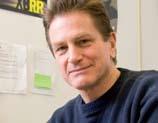
55
The greening of the cities

Getting the ‘green light’
Looking green, thinking green, shaping green cities, and living green. Local administrations are leading the way.
64
Head Hunters seek ‘enthusiastic multi-specialists’ Managers’ attiditudes


Human capital can help to start a new cycle of growth and economic development.
66 Global overview Movers and shakers
IIC Partners : “We bring you a world of talent”.
69
28
Heroic managers
A dreamer in the realm of HD
Humility, courage and, above all, passion are what we found in East Troy, while meeting Erik Buell, one of the pioneers today’s motorcycle race technology.
30
Unusual jobs
Ringing the changes
Circuses are more an existential condition than just an artistic enterprise.
33
The Best Job in the World The Island dream
Winner of the The Best Job in the World, Ben Southall 34-year-old tells us about his adventure on the islands of the Great Barrier Reef.
35
Speaking volumes
Let me tell you a story
In a relationship based on trust and reciprocal recognition of reputation, guest speaker agencies help you organize events.
42 Obama Style
The ‘review culture’ Obama seeks a face-to-face meeting with his staff. 44
Art cities Capitals of the culture
Each year two cities are selected as Europe’s Capitals of culture (ECoC).
58
Polluted cities
The cost of doing business
How companies can benefit from an active contribution to a less polluted site and city.
60
Furniture: not sitting down on the job
Simplicity & sustainability
Fatal error Woods Redux
Can companies learn something from Tiger Woods?
47
New York City
The
city that never stops
The epicenter of the global financial earthquake thinks positive.
52
São Paulo
The financial hub of Brazil
The Work Cities Guide is now heading to São Paulo, a Brazilian boom city.
The investments in furniture are just 1% of company costs. The office furniture industry has suffered a lot as a result of the economic crisis. We interviewed several office furniture industry companies to see how they are coping with the downturn.
63
The stylish workplace Aesthetics and happiness
In a world where the environment no longer seems limitless, meaning will increasingly be sought in workplaces that are genuinely committed to corporate social responsibility.
72
To be cool
72 Design ideas
iF International Product Design Award 2010.
73 Fashion in the world
The Business side of style portraits of Axel Knapp, Ana Claudia Fatia, Simon Hammerstein.
85 Our choices
88
Book selection Exciting new releases
5
t ws m — #3.10
Editorial
By MIRKO NESURINI
AS OF APRIL 2, 2010 THE WORk STYLE MAGAzINE WILL ALSO BE AVAILABLE AT NEWSSTANDS EUROPE-WIDE AND IN THE USA.
The only international magazine entirely dedicated to work style, our publication provides in-depth news, reviews, studies, and suggestions on topics ranging from life style to the business world.
This year, the key challenge in the job market is overcoming the crisis without adding more problems to those that exist already.
In his article, Allan Hall underlines the importance of keeping things steady, and knowing how to sail through rough waters. Some (people) have had to face ‘hot’ issues that are difficult to overcome. Think Tiger Woods, for instance. A keen analysis from Roger Abrams gives us analogies with corporate crises. The movie Up In the Air, starring George Clooney, provides Aneil and Karen Mishra with the opportunity to analyze how being downsized can be the first step to a positive change. Barack Obama has changed the approach to problem-solving on the part of governments. Paolo Valentino outlines the “method” of this change, which is based on systematic fact-checking, a strong consultant network, and the involvement of a restricted group of ‘followers’ during the decision-making phase. As per usual, we have a number of enthralling stories about people. There’s our special edition on NYC and interviews with Erik Buell and Ben Southall, as well as a fascinating article on São Paulo (with a guide attached) edited by Bahar Puraligil. All examples of the dynamism of people around the world.
Fabian Uzaraga tells us about the most beautiful work environments with the help of Alain De Botton, author of The Architecture of Happiness. Then we have a test on colors conducted by Usa Today, a wide selection of books, and a whole section dedicated to work places.
Don’t forget to check out our ‘To Be Cool’ pages which have been redesigned with the help of Demetra, a young stylist whom we are sure you will like.
Last but not least, illustrator Gaku Nakagawa is back. He’s providing drawings for our magazine, along with other interesting artists.
In short, this issue of The Work Style Magazine is designed to convey optimism and the determination to go for growth. Enjoy.
Mirko Nesurini Chairman
mirko@theworkstylemagazine.com
Note: Authors’ names are given in full in the first article, while an abbreviation is used thereafter. The remaining piece are by members of the Editorial Board.
Bassano
Mocellin Francesco
Member of the Circus and Travelling Entertainment Committee at the Department of Culture since 2002, Italy.
Boston
Roger I. Abrams Richardson
Professor of Law at Northeastern University School of Law in Boston.
Brighton
Steven Wilson Illustrator who lives and works in Brighton, UK.
Caracas
Reynaldo L. Vásquez
Illustrator. His works have been shown in many publications and galleries around the world.
Carbondale
Alan Vaux Professor of Psychology and Dean of the College of Liberal Arts at Southern Illinois University Carbondale.
Como
Rosario Imperiali Columnist on Il Sole 24 Ore and he has authored several data protection manuals.

Decatur
Goni Montes Scientific illustrator, editorial and advertiser.
t ws m — #3.10 6
Contributors around the world for The Work Style Magazine.
Darlinghurst
Victor Pisapia Founder of VictorsFood, specialized in Cooking Team Building activities, cooking classes, food coaching and consulting.
Delta

Julie Burke Owner and Founder of Tall Order. She knows the unique formula for ‘raising the bar’ in servicing her client’s expectations in the catering and team building business.
East Lansing
Aneil and karen Mishra
Aneil and Karen are both professors at Michigan State University.
Glendale
Jan Northup President of Management Training Systems, is an internationally recognized author, speaker, and organizational strategist.
kuala Lumpur
Antonio Corbi Lawyer and Entrepreneur.
Libertyville
Brian Palmer President of the National Speakers Bureau. He is an active member of a number of industry organizations.
Lyon
Sophie Desjardin Editor in Chief at Euronews.
London
Neil Hogan Creative Director of Spence Harris Hogan -SHH Design.
Hanna Melin Freelance illustrator and artist.
Milan
Demetra Dossi, 21 year old student who has created pigchic. com, a blog that talks about fashion and trends.
Andrea Ceriani CEO of KKIEN Enterprise, a training company offering programs in organizational development and addressed to major Italian companies.
Munich
Lutz Duerichen Life Style Photographer.
Naples
Riccardo Imperiali Heir of one of the oldest aristocratic families in Naples (Italy).
Neuchâtel
Luca Brunoni
Lawyer with a Master in Sport and Business Law from the University of Neuchâtel.
Newberg
Craig E. Johnson Professor of Leadership Studies and Director of the Doctor of Business Administration program at George Fox University in Oregon.
New Dehli
Sachin Joshi Deputy Director of the Centre of Excellence for Sustainable Development, New Delhi.
New York City
Peter Arkle Freelance illustrator of books, magazines and ads.
Charles Beckwith Editorial fashion photographer based in NYC.
Scott Michels Freelance journalist specialized in government, legal affairs, law, crime, courts.





Suzen O’Rourke Owner of Cooking by the Book.
Carlton Sedgeley Founder and President of Royce Carlton. Matthew S. Seminara Attorney practicing in the areas of corporate, real estate, and labor and employment law.
Rotterdam
Eelco van den Berg Illustrator, graffiti writer and dj.
San Francisco
Michael Frick Founder and President of Speakers Platform.
São Paulo
Ruy Shiozawa CEO at the Great Place to Work Institute® Brazil.
Claudio Edinger Brazilian photographer and award winning author of twelve books.
Singapore

Samia Ahad Successful businesswoman turned chef, and now food entrepreneur.
Sofia
Daniela Dimitrova BMW manager in Sofia.
South Orange
Bill Lee Vice-President of Client Development at Eagles Talent Speakers Bureau.
Stockholm
Erik Wachtmeister
Founder of ‘aSmallWorld’. Unlike other social networks, ASW aggregates an existing community of people that are already highly connected.


Taiwan
Yihsin Wu One of the most important illustrators in Taiwan.
Tokyo
Touko Okamura graduated from Nihon University College of Art with a major in Photography. In 1997 Touko launched her career as a freelance illustrator.
Washington
Paolo Valentino Corriere della Sera’s correspondent from Washington since 2007, where he initially reported on Barack Obama’s campaign.
Windmill Hill
Berry Winter is director of JamBerry and (he is) specialised in providing performance training and coaching for people in business.
t ws m — #3.10 7
Contributors
Thinking out of the box Critical thinking online
SOCIAL MEDIA: SOME ARE SIMPLE ‘AFTER WORk’ ACTIVITIES SUCH AS SOCCER CLUBS Others are similar to English clubs for gentlemen only: it is difficult to get into such clubs and once you are a member, maintaining constant rigor is necessary. The truthfulness of information should be mediated by users through their own ‘right thinking’. Truth and counterinformation can be found: maybe this is also why social networks irritate regimes so much.
Truth in information
After working as an investment banker for 20 years, I started to think of online opportunities in 1998. To me, the Internet immediately presented incredible opportunities to harvest and aggregate the human mind and behavior.
A NEW kIND OF SOCIAL NETWORk
For many years I had known the existence of a global community of people who connect and continuously gravitate towards each other. This after having lived in and travelled to many places across the globe, running into the same people over and over again, looking for the same things. I identified this community and gave it a name (aSmallWorld), the tools to connect and reconnect and to exchange trusted information. What I noticed was that the members of this existing community have a strong need for privacy and private peer-to-peer information. It became obvious to me that there was a real need for an ‘oasis of intimacy’ on the Internet, with trusted, relevant and objective information. The Internet and social networks in particular have been plagued by information overload and filled with commercial bias.
THE INSPIRATION OF ASMALLWORLD
I launched aSmallWorld (ASW) in March 2004 and was one of the very first pioneers in this space. At the time Facebook was just launching in the USA. ASW allows people with common interests and mutual circles of friends to interact with one another. Unlike other social networks, ASW aggregates an existing community of people that are already highly connected. ASW had a dramatic initial

success as it hit a sweet spot among hundreds of thousands of people who needed a trusted place to connect and exchange information. Platforms like Facebook, MySpace, LinkedIn and Hi5 have received most of the attention. Here, members can maximize quantity, but not necessarily the quality, of interaction. The thought of connecting to the entire universe can be fun, but the risk is that the noise of too many people can easily drown the signal of relevant information. That is particularly true in this new age when time is becoming increasingly precious. I have always striven to follow a different approach: to have a code of civilized behavior emulating the real world, capture real-life relationships between people, not random contacts. We highlight relevant and genuine content devoid of commercial bias, enabling people to gain valuable insights and knowledge from each other. The notion of capturing the ‘collective intelligence’ of the local
expertise within this group is compelling. I realized ten years ago that an Internet platform would be ideal for this purpose. Meanwhile, the Internet has its own issues, being rife with information overload, commercial bias, random behavior, and anonymous people. I read Malcom Gladwell’s The Tipping Point back in 2002 and it became a great inspiration. The whole notion of connecting the ‘Connectors’ and ‘Mavens’ referred to in this book is the essence of a successful social network, particularly on a global scale. Connectors ‘know everyone’ and facilitate bonding between large numbers of individuals. Mavens are local experts on vital information that others need. To me, it is very exciting to be able to ‘unlock’ the vast potential in the equation of demand and supply of trusted info.
DIFFERENT SOCIAL NETWORkS
Social networks have different purposes. One is to provide the opportu-
8
t ws m — #3.10
01 Erik Wachtmeister is the founder of ASMALLWORLD Holdings Inc. Erik holds a BA from Georgetown University School of Foreign Service and an MBA from Insead. He launched “asmallworld” in March 2004. Unlike other social networks, ASW aggregates an existing community of people that already are highly connected.
nity to connect with everyone on the planet. Another is to create an environment just as in real life where you select the people you want to communicate and engage with and receive information that is truthful, objective interesting and relevant. Private English member clubs follow the idea of having a home away from home. Social networks can adopt the same notion. People don’t let everybody into their homes, private dinners or wedding parties. It is more compelling for real friends to exchange valuable advice and entertaining information on just about anything, if there is a perceived oasis of intimacy.
WHAT CONSUMERS WANT
There is no question that the Modus Operandi of almost every social network is to capture an audience as well as capture vive user-generated information that comes with it. Sooner or later the bills need to be paid and shareholders need a return. Revenue models typically include a free model with premium services, different types of advertising models, and e-commerce. Consumers of online media ultimately determine the successful models by their activity on the websites in question. It all comes back to what consumers want for their investment in time and information sharing online. They want information that is genuine and truthful. In my opinion they can best get this in an environment that resembles real life and where the chaotic forces of the WWW are tamed and where the information is filtered and curated. I anticipateddifferent forces that would later create a dilemma for social media publishers. One of the ultimate goals of
consumers of online information is to be entertained and also enlightened and better informed about what is of particular interest to them. At the same time there are the goals of those who wish to promote products, services and brands, often under the radar of what is obviously publicity. In traditional media there are rules that govern what is editorial and objective, and what is a sponsored message. This boundary is sometimes blurred with product placement, branded entertainment and ‘objective’ statements by well known personalities. In social media, people have the opportunity to promote one another and each other and it can be a bit tricky to sift out what is genuinely objective information. Yet there are great tools that we can apply where the most “trusted” people rise above the rest or where promoters are weeded out if they get too aggressive. Filtering genuine and relevant content is an important and delicate task for any social networking community that wants to preserve integrity to its online forums and communication between its participants.
TRUTH AND INTERNET
Selection of social network
• facebook.com keeping up with friends, upload an unlimited number of photos and share links and videos.
• netlog.com keeping in touch with and extend their social network. Netlog is currently available in 20 languages.
• hi5.com available in over 50 languages. Popular in India, Portugal, Mongolia, Thailand, Romania, Jamaica, Central Africa and Latin America.
• bigadda.com is the largest web and mobile Indian social networking site.
• friendster.com with more than 110 million members worldwide, it is popular in Southeast Asia.
• linkedin.com is a network of experienced professionals. representing 150 industries in 200 countries.
• pbnworks.com has the purpose of networking and enhancing member businesses (200 countries / 60 million member).
• tagged.com third largest social network in the US, and 80 million members worldwide.
• twitter.com is a real-time information network powered by people all around the world.
• viadeo.com used to find clients, suppliers, business partners, jobs and employees.
• xing.com is the global business network with over 8 million business professionals.
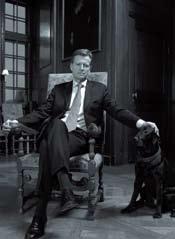
exist side by side in the Internet’s electronic universe. What’s to be done? There are no electronic filters that separate truth from fiction. No cognitive ‘V-chip’ to sort the gold from the lead. We have but one tool to apply: critical thinking. This truth applies as well to all other communication media, not only the Internet. Perhaps the World Wide Web merely forces us to see this more clearly than other media. The stark juxtaposition of valuable and valueless content sets one to thinking. Here is an opportunity to educate us all. We truly must think about what we see and hear. We must evaluate and select. We must choose our guides.
I will end with a quote from the Father of the Internet, Vinton G. Cerf: “Truth is a powerful solvent. Stone walls melt before its relentless might. The Internet is one of the most powerful agents of freedom. It exposes truth to those who wish to see it. It is no wonder that some governments and organizations fear the Internet and its ability to make the truth known. But the power of the Internet is like a two-edged sword. It can also deliver misinformation and uncorroborated opinion with equal ease. The thoughtful and the thoughtless co- •
t ws m — #3.10 9
”
Illustration by Touko Okamura, Tokyo, Japan
Thinking out of the box See the world in color
CHOOSE For example, when 877 members of Usa Today’s CEO panel took an online personality color test, they were three times more likely to favor magenta than the public at large, three times less likely to select red, and 3.5 times less likely to choose yellow.
CEOs show true colors
This, it turns out, is more than a curiosity. Psychiatry professor Rense Lange, an expert on tests for everyone from students to job hunters to those with early signs of Alzheimer’s disease, has been looking hard at color tests. He has reached the conclusion that the results all but prove that CEOs are wired differently.
SELF-ASSURED, DOMINANT AND PERFECTIONIST CEOs are often wired in counterintuitive ways. For example, the color test shows that the typical CEO is more sensitive and private than the typical person and is less likely to be a perfectionist or to be dominant and more likely to be emotionally unstable. CEOs, it turns out, are not as self-

assured as the public at large, and they are more cooperative and less forceful than the typical person, says Dewey Sadka, who has spent the last 15 years refining the color test completed by the 877 current and retired CEOs and chairmen. The heavy response from Usa Today’s CEO panel provided a significant database that was then examined against 750,000 others who have taken the online test.
A 60-SECOND TEST
The test takes about 60 seconds. It is almost entirely visual and asks people to click on colors, sometimes ordering as many as 15 colors from favorite to least favorite. The results turn out
a personality profile that is far from perfect, but is proving to be as valid as more established and lengthy verbal tests such as Myers-Briggs and the Gallup StrengthsFinder. The results can steer people toward a career that matches their personality and strengths with jobs they might find enjoyable. Unsurprisingly, the CEOs as a group were suited for jobs in upper management, but they also were better suited than the average person to be social workers, artists and teachers. Lange said that this made sense because the ability to motivate is important to both teaching and running a corporation. “CEOs see the big, bold and colorful picture and help others see the vision as well”, said test-taker
10
t ws m — #3.10
ASk CEOS TO PICk THEIR FAVORITE COLOR AND WHAT THEY SELECT WILL OFTEN BE VERY DIFFERENT THAN WHAT MOST PEOPLE WOULD
Illustration by Steven Wilson, Brighton, UK
01
02
03
By DEL JONES
Edward Jennings, CEO of Copanion, which provides tax professionals with Web-based applications. “Leaders are storytellers, teachers and investors”. Administrative assistants might be surprised to learn that the color test indicates that the typical CEO is wellsuited to be an administrative assistant. Jake Geleerd, CEO of Chicago real estate company Terrapin Properties, offers an explanation: “It’s because CEOs probably had their assistants take the test for them”, he jokes. But Marion Sandler, a former Fortune 500 CEO at Golden West Financial, took the test for herself and learned that she might enjoy a job as secretary, paralegal, clerical worker or bank cashier. “It made me laugh”, Sandler said. “When I was 8 years old, I aspired to be a sales clerk, but then I grew up”. If CEOs might make good teachers and administrative assistants, might teachers and administrative assistants make good CEOs? “I wouldn’t be surprised”
Lange says. However, the test warns that people will find job recommendations below or beyond their capabilities.
A NEW WAY TO DISCOVER POTENTIALS
Lange says no one knows why so much can be learned about a person by the colors they choose. Those answers are buried deep in neuroscience, he says, but it’s just a matter of time before marketers will be able to target products to consumers based on color preferences. Color tests are much easier to administer than something like Myers-Briggs, and color tests aren’t easy to influence. For example, someone applying for a job as a police officer might attempt to game a MyersBriggs test by guessing the correct answers, but they would have no idea how to rank colors.
Color tests can also be quickly expanded worldwide. Vijay Eswaran, the Malaysian executive chairman of
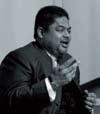


QI Group in Hong Kong, took the test for Usa Today and said that it accurately described his personality, though he was taken aback by potential jobs he would be good at: mechanic, emergency room supervisor and telephone technician.

“The suggestion that I might have made a good dental assistant made me pine for lost opportunities”, said Phil Libin, CEO of technology company Evernote. CEOs were promised that their individual results would remain anonymous, and it’s unknown what percentage believe the test accurately reflected their personalities. Some who volunteered comments said they were unconvinced. Bruce Clarke, CEO of consultancy Capital Associated Industries, likened the color test to a “horoscope or astrological sign analysis”.
SOME CEOS SOLD ON RESULTS

But most CEOs who provided feedback said the test was eerily accurate, including Greg Babe, CEO of Bayer, and Hamish Dodds, CEO of Hard Rock International. “I was floored”, Dodds said.
“I must say I was very skeptical, but it does a darn good job of summing me up”, says David Haffner, CEO of manufacturer Leggett & Platt. “I wonder what I’d be like if I liked lime green and purple?” “It identifies the tension in my personality between facts and creativity”, said James Fugitte, CEO Wind Energy.
Of the CEOs who took the test, four men and one woman said they are colorblind or partially colorblind. Those include former Southwest Airlines CEO Howard Putnam and Brian Scudamore, who founded 1-800-GotJunk 20 years ago and now has 300 locations in three countries. “I’m colorblind, yet the results were still bang on”, he said.
t ws m — #3.10 11
•
Brian Scudamore founder and current CEO of 1-800-Got-Junk
Greg Babe, president and CEO of Bayer Corp and Bayer MaterialScience LLC
Vijay Eswaran, the Malaysian executive chairman of QI Group
] 01 02 03
[W bayer.com capital.org copanion.com evernote.com hardrock.com leggett.com qi-ltd.com southwest.com terrapingroup.com usatoday.com windenergycorp.com worldsavings.com 1800gotjunk.com
Thinking out of the box Design evolution
WE NEED GREAT IMAGINATION TO ENVISAGE THE FUTURE, but, conversely, one of the greatest problems with most forms of future-forecasting is our tendency to be too imaginative. It’s only too easy to exaggerate our appetite for change, whereas in fact our human instincts simultaneously embrace the new, whilst clinging resolutely to the known.
The workplace of the future

01
With a more realistic appraisal of life’s yin and yang, we see that each new advance may also have a hidden downside. Major shifts do, of course, occur at regular intervals in the way we live and work, often birthed from new technologies. But we rarely change everything at once, nor should we.
THE INTERACTIVE FACE
It would be great to strike a pose and say that there will be no offices in the future—that instead, we will all be working at home or in our gardens or at the beach, via our virtual offices and technologies-on-the-move. But it would simply not be true. However much people complain about the fact that they have to go to work, theyactually like going to the office - and they likely always will. The office forms a necessary break from home life and remains the best route to productivity, thanks to interactive possibilities for brainstorming and team-working and the superior communication that results from face to face contact. Workers also need an environment for social interaction, even if it’s only to moan or gossip over a cup of coffee in the kitchen. For younger members of staff, the office is often a particularly important social space in which to make new friends—or even to meet a future partner!
NATURE: THE GREATEST INSPIRATION
So, if the physical office is to survive, what will it look like, and what factors are acting on its changing shape? There have been a few notable office projects in the media recently, which are multi-coloured, all-singing
all-dancing 24-hour environments, including lots of play and chill-out spaces. Great for a press story, but perfect examples to my mind of our tendency to ‘over-imagine’. We cannot get away from the fact that people come to offices to work and they leave the office to play. The answer to the increasingly flexible ways of working is NOT to make the office the answer to all of life’s needs! This doesn’t mean there shouldn’t be some elements of entertainment incorporated into office design. But ask any employees or bosses and the answer will be the same – you come to the office primarily to work and everything should be geared to facilitating this; given the choice, most people would vote overwhelmingly for shorter working hours, rather than reinventing the office as a home / hotel / bar / night-club environment. For an effective breakout space, nature remains the greatest inspiration, with fresh air, outdoor gardens or, even better, a roof garden, acting as a wonderful antidote to stress.
SPACES THAT CHANGE
The most reliable route for predicting the future is to look at the changes already taking place and consider which of these form major trends? Transport is a major area of change right now, for example. More and more of us are looking for greener and healthier ways to travel to work and we have seen a huge increase in the use of bicycles over recent years. One or two of us have even purchased electric bikes. As a result, we will soon need to design a dedicated docking stations to accommodate all these bikes safely. A knockon consequence of this change is that staff need to change out of their biking clothes into smarter work clothes. Therefore more showers and changing areas will need to be added to the office space.
HELP FROM TECHNOLOGY
Like our office, every office has a very specific culture, determined by what is done within it and the types of people employed there. It seems obvious
12
t ws m — #3.10
01 Meeting space at the multi award-winning Manchester Square offices in London
02
03
04 Breakout space at the Manchester Square offices 03
04 02
beyond belief, but it’s amazing how few companies ever ask their own staff how they would like their future office to look and operate. Although the home office will never replace the physical office, more and more people across all types of industries will nonetheless be working partly from home or more flexible hours. The result will be increasingly ‘intelligent’ office spaces with an ever greater numbers of tasks automated. The liberating mobility brought about by convergence devices will be added to by new devices such as Apple’s iPod. Hot-desking is also a trend that will not go away, with shared workspaces on the increase. More work needs to be done here to allow for personalisation, though no one wants to sit in a bland space. This can be done by having personal storage or document drawers that wheel around to any desk in the office, for example, along with personalised digital settings not only for screens, but for desk surface lighting and for the creation of a digital wall for personalised memorabilia.
DIFFERENT SPACES FOR DIFFERENT DEGREES OF FORMALITY


It also follows that if more time is spent out of the office or on flexible hours, the ritualistic importance of gathering all staff together at regular intervals will increase. A good way to deal with this would be by having communal office lunches a couple of times a week. A chef could be brought in and hearty and healthy food could be provided for free to encourage attendance.
The era of the single open-plan office is surely coming to an end. Clients realise more and more that they need zoned areas – some private and some completely public, with meeting rooms offering differing degrees of formality. For their Manchester Square office project (winner of the International Interior Design Prize at the International Property Awards, amongst others), for example, SHH created dramatically-different spaces for different types of client or internal meetings.
SOUND, LIGHT AND ART

The design of sound will be of increasing importance to encourage people to do their best work: sound muting, ambience perfecting and the removal of reverberations and white noise can hugely increase a sense of calm at work. There is also no excuse for poor lighting, which should always be clean and of high quality. Art is another great humaniser in the office environment and can be a very eloquent embodiment of client values and attitude to staff. For the Manchester Square project SHH commissioned artist Hugo Dalton to create easily-updateable wall projections to animate the different circulation areas (sketches of ballet dancers morphed with floral motifs, lasercut onto stainless steel disks and fitted into ceiling-mounted projectors), with highly striking results.
The most important aspect of materials and furniture is always that they are of a human scale, good to the touch, warm and vibrant. Whatever else may change, the human animal and his or her needs will remain constant.
t ws m — #3.10 13
•
Neil Hogan, Creative Director of architects and designers SHH
Outdoor spaces offer a great antidote to stress
[W shh.co.uk]
No matter how rewarding, work can often challenge or even disrupt other parts of your life—not least when it requires long hours, unpredictable and urgent demands, or travel from home. Indeed, the more interesting, challenging, and higher-level the job, the more likely it is to assault other aspects of your life: to make demands on time, thought, and emotions. Bringing work home can disrupt home or even prevent its development! Rewarding and enriching in so many ways, work can play havoc with your social life and lead to loneliness and unhappiness. Humans seek affiliation with others and, when that is difficult and people feel disconnected, they become distressed and lonely. These simple truths are the tip of an iceberg that can lead to intense depression. A significant event for many in the workplace is a transfer. Like all transitions, it presents opportunities: for novelty,
excitement, and growth; as well as challenges: possibly disruptions, loss, and stress. Of course, how an individual handles a transfer—whether it is calm or intensely emotional, exciting or upsetting, on balance a huge success or a traumatic disaster—is shaped by numerous factors: personality, life history, attachment experience, social networks, life and work circumstances, and coping strategies. According to social support theorists, if you feel that you are liked, involved in a network of mutual obligation, esteemed, and loved, you are more likely to be resilient, satisfied, and happy. Moving to work in a new city may threaten these benefits. It may disrupt friendships, threaten intimate relationships, and even challenge marriages. So, how can you avoid loneliness and make an enriching transfer.

t ws m — #3.10 14
Illustration by Goni Montes, Decatur, USA
Editorial Dangerous changes
By ALAN VAUx
LONELINESS AND DISSATISFACTION CAN OCCUR WHEN MOVING TO ANOTHER CITY FOR WORk. These feelings come from the uncertainty of being liked, involved, appreciated. The best advice for being happy in unknown places is to establish new habits and identify places to go: bars, restaurants, grocery stores, gyms. A new love interest could be a ‘cure-all’, but this is a different story that cannot be scheduled obviously.
Avoiding solitude
RETAIN THE ASSETS YOU HAVE!
Take stock of the relationships in your network and sustain them. If you are involved in a stable relationship or marriage, this may be central to your support network. A ‘full service operation’, helps you to feel liked, valued, and loved, as well as providing all sorts of social support in your life. Make the effort to nurture it through frequent, thoughtful communication. The same holds with close friendships. This is a lot easier with today’s technology: twitter, e-mail, smartphones, and digital photos and videos.
REBUILD REWARDING ROUTINES
Moving can involve a pervasive loss of rewards—since usual behaviors no longer yield familiar pleasures. So, make sure to bring old routines and pleasures with you: favorite books, music, and habits. Build new routines that generate small, familiar pleasures: enjoy being recognized and greeted by the barista and newspaper seller; find short walks that yield familiar sights; find cafés, shops, or restaurants where you can become a ‘regular’. Such strategies can make an overwhelmingly strange place start to feel more comfortable.
COMPLEMENT ROUTINES WITH ExPLORATION
A new city should offer much to see and experience: pace yourself to avoid becoming overwhelmed. If time and money are scarce, do some of this through new newspapers and magazines. You can acculturate, explore, and—worst case—fill time and distract yourself from a painful sense of isolation

REBUILD YOUR SOCIAL NETWORk
It is important to recognize this as a major project and to remain optimistic. There are different kinds of loneliness. To simplify, social loneliness may result from feeling less socially integrated or involved, because of insufficient socializing and contact with others. Emotional loneliness may result from feeling less attachment and love, because of the absence of close relationships. So, it is smart to build a social network of individuals with diverse interests, locales, and potential. Take advantage of the new workplace: get to know new colleagues, appreciate any recognition that comes with your new position, accept offers to socialize or be shown around, and enjoy after-work social dates. But, try to make connections outside work too, building on your interests.
RECOGNIzE YOUR PERSONAL ASSETS AND LIABILITIES
How we handle a move depends in part on our personality, network orientation, and attachment style. We vary in how prone we are to experience negative emotions such as loneliness, anxiety, and depression. We vary in our confidence that others in our social network would be glad to help us out. We are more or less likely to question whether others are trustworthy or that we are worthy of their caring. So, even an objectively similar move may be experienced very differently by different people. Those who face more challenges may benefit by recognizing their liabilities-their expectations, patterns of thinking, and emotions—and by trying to accommodate them. If you know that
you tend to over-react to slights, to doubt others’ gestures of friendship, or to experience self-doubt or hopelessness, you might be better able to adjust your perceptions and feelings. Some younger people may be happy to pursue a career and forego a longterm relationship, at least for a while. Some may still have to use strategies like those outlined above to ensure sufficient socializing and time with friends to avoid social loneliness. Others, likely more as they get older, will find that despite career success they find themselves emotionally lonely: wanting—perhaps longing for—a deeper attachment. Moreover, some may be eager to have children. Opportunities for romance and the pool of available mates may change rapidly during early adulthood. Generally, men and women who are married show lower depression, psychological distress, health behavior problems, illness, and even mortality, than those who are divorced, separated, or never-married. Some of these associations are due to ‘selection’, but some are benefits of a long-term relationship. These benefits vary. Under the right circumstances, they may expand an individual’s capacity to multi-task, nurture a richer self, and promote feelings of being cared for, respected, and loved, resulting in resilience, health, happiness, and life satisfaction. How best to navigate these choices in a complex, changing environment is perhaps a subject for another article. •
[W twitter.com] t ws m — #3.10 15
Data transfer Silence is not always golden
By ROSARIO IMPERIALI
Data protection is freedom

in recent times from legislators, in the attempt to ensure that business is lawcompliant. Legal obligations addressed to corporate officers, however, have proven of little help in effecting true compliance. Having learned the lesson from the global financial Crash and various abuses, national legal systems have started to require corporations to adopt anti-crime schemes.
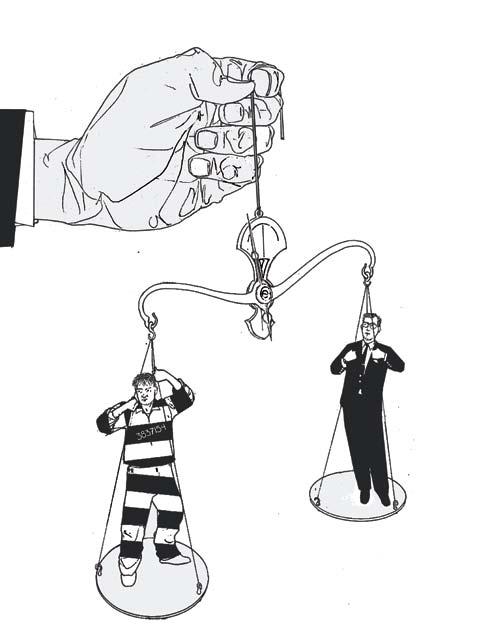
Imagine that you are the CEO, or the HR director, of a renowned and wellrun company. Despite the company’s compliance policy, something goes wrong. Wouldn’t you want to know right away, rather than waiting for the situation to become irremediably compromised? The international arena has witnessed numerous interventions
In this regard, the UN Convention against Corruption - which came into force in 2005 – has also played an important role. Legislation such as the Sarbanes-Oxley in the USA, the Public Interest Disclosure Act in the UK, as well as Law 231 in Italy go in this direction. They all compel corporations to implement an internal management system tailored to prevent criminal conduct. The goal is the same: to achieve legal compliance, thus reducing corporate crimes to the minimum.
Parallel to finding adequate rules and regulatory controls, comes the acknowledgment that, not infrequently, the staff of the corporations involved in those disasters had been aware of the grave risks being taken. This recognition has fostered a ‘cultural shift’: challenging malpractice or misconduct in one’s own workplace is right, safe, and
01 02
•
acceptable. By launching the slogan ‘Silence is not always golden’, so-called ‘whistleblowing’ corporate schemes have taken off. The implication of this new culture are far-reaching. These whistleblowing schemes are underpinned by a culture of transparency and accountability that breaks with complacency and cover-ups. Having said that, it becomes immediately evident that this new trend needs to resolve two key issues: how to protect the guy who makes the disclosure from possible reprisals, and how to cope with data protection implications. In fact, the legal safeguard against reprisals is a prerequisite in the fight against the ‘mind your own business’ attitude. A solution for whistleblowers is to push them under the umbrella of legal secrecy. Secrecy, however, raises issues in other perspectives. Under the data protection discipline, for instance, which is based on the principle of transparency on how personal data are used, data subjects should be previously informed, thus allowing them to access their own data and to exercise specific privacy rights. The group of representatives from the independent national privacy authorities, the so called ‘art. 29 working party’, already issued an opinion in late-2006. The opinion, rather than finding clear-cut answers to the issues, basically recommends adopting balanced behaviors. Much has still to be done on this front and the privacy Commissioners have already asked the EU Commission and their national parliaments to provide a correct balance between the two legitimate goals: corporate anti-crime schemes and data protection.
[W facebook.com un.org weforum.org]
CONTRARY TO WHAT MARk zUCkERBERG, the founder of Facebook recently stated at the 2010 World Economic Forum in Davos, data privacy is far from obsolete. It is what allows each of us to maintain our dignity in our private lives, just as occurs in the workplace. A delicate balance needs to be achieved between complex values.
16
Illustration by David Johnson, Windham Center, USA
“How to blow the whistle and protect employees’ dignity”
Training It’s time for the sturdy sailors
By ALLAN HALL
THE IDEA THAT ‘WHEN THE GOING GETS TOUGH, THE TOUGH GET GOING’ has never been more relevant than in these hard times of recession and uncertainty. During training, companies from all over the world, pay particular attention to the skills of people who face extreme life situations such as death and strong adrenalin rushes, in order to adapt these people’s teachings to their own case.
Sliding competencies
It has long been known that international business has looked favourably on the ex-military caste; leaders of men who command respect and who instill leadership are sought by headhunters around the world. But now fire fighters, ambulance crews and even people who work with the mentally ill are being in demand to transpose their skills into the world of finance and commerce.
01 Colin Powell and Norman Schwarzkopf 02 kickboxing Fighting

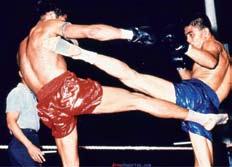
Lisa Maclean is just such a person. A master motivational coach in the UK with extensive experience within the health and criminal justice sectors, her career began within the health sector as both a general and psychiatric nurse. Recently she was employed as a consultant nurse within an accident and emergency department and a male prison. Her health background and training in psychotherapy complements the coaching, which is her main focus. A hallmark of Lisa’s career has been at the cutting edge of change within the NHS, Higher Education and more recently the Prison Service. Currently a Senior Lecturer in Nursing at the Open University, Milton Keynes, England, Lisa believes that her skills are “best placed for facilitating and empowering others to make the changes necessary to fulfil their ambitions”.
Tom Rollings, formerly an ambulance administrator in London, switched jobs when he hit 40, five years ago, to work as an independent business consultant. He now has a client list 250 strong.
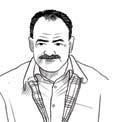
He said; “Despatching people to save
lives requires instant decision making and a cool head. It meant the proper and correct harnessing of resources. When the recession hit, I think my training stood me in good stead to be
crucial, particularly in the downsized world we are living in now.“It is commonly assumed by decision-makersparticularly in business - that choices are usually made after they’ve given
able to see the wood for the trees, to make the right calls at the right time.” Then he adds that “in these days, of volatile stock markets and diminishing returns, such cool-headedness is vital”.
In America, a popular website for firemen is www.firefighter-biz.com, devoted to those fire fighters who work a second job on top of their alldemanding main one. It connects fire fighting personnel with others who have started small businesses, capitalising on their innate bravery in the face of a wall of flames to brave the equally daunting cosmos of entrepreneurship.
“Firemen are increasingly in demand in the business world”. said Berlin business consultant Paul Hickl. “People like their ability to make quick, decisive decisions”.
Actually, Tom took a decision borne out of his training. And that kind of instant, motivating, team-player stuff is
the subject in question a good deal of thought and weighed up the options. That’s all well and good - but for men and women who have worked with the services who stand guard on all of us, their is a gut instinct at play whose value is infinite and which can’t be quantified but is amazingly important”, he says.
Dan Jordon, a county sheriff’s deputy in Los Angeles, has combined his highpressure job – often facing life-threatening situations – with being a motivational speaker around the world.
He knows all about that too – together with Los Angeles City Fire Department Firefighter John Hicks, he has written a soon to be released book enttitled, First Responders Handbook of Humor. He added; “This book providing a valuable learning tool for dealing with stress, less any psychobabble or legalese. Emergency services people know about this stuff,” said Hicks. “Because they live through it every day”.
t ws m — #3.10 17
[W ci.la.ca.us firefighter-biz.com open.ac.uk] •
02
01
Recognition Cooking as team building

MANAGING A COMPANY AND MAkING DECISIONS WHILE COOkING ARE PARALLEL UNIVERSES Choosing ingredients and staff; establishing timeframes, conditions, and goals; managing emergencies, and solving problems in a creative way, working as a team. These activities facilitate communication and are often fun to do. Morever they bring people together. While aimed at management, these courses are also suited to lower-grade staff who draw results from such activities in their interaction with colleagues.
Getting a taste for training
LEARNING BY DOING
To learn by doing denote “a particular training activity consisting of two phases: the active one (doing the action) and the reflective one (understanding the meaning of the action).
The results of actions and the reflections about these actions, give rise to behavior changes and improvements”. So writes Andrea Ceriani, author of Il Manager in cucina (The Manager in the kitchen) and founder and General Manager of the Italian training company KKIEN enterprise. According to him, a Cooking Team Building experience is one of the most effective training and corporate bonding strategies: “helping to improve the ‘group spirit’ in a new, involving, active and amusing way thus assuring the participants the best conditions to ‘get in the game’, improve selfconfidence and put faith in the group; to develop one’s leadership and sense of responsibility; to work up the courage and ability to face changes, and new unforeseen situation”. He himself is organizing Cooking Team Building activities for his trainees and clients, and explains the routine of a CTB class.
CTB FIVE STEPS:
The first thing, the appointed trainer «introduces activities and goals; “Then he forms the teams of work and it’s not easy because the groups must be ‘equalheterogeneous’, both on the cooking level and on the functional level!”; Once the groups are made, they can get started with the cooking. Within a set time, they are asked to prepare “all the dishes on the menu, under the watchful eye of the trainers and of the camera, that films the entire activity”. “At lunch time judges and trainers can taste the dishes
and evaluate the activity; then in the afternoon the trainers lead a debriefing, where the experiential activity is considered in relation with the professional pattern, and the keys are given to the participants to make them understand how to transfer cooking skills to their daily job”.
ENJOYMENT, SOCIALIzATION AND BUSINESS MATTERS, ALL IN FEW HOURS
Cooking by the Book is a New York firm offering customized culinary team-building events. When organizing a CTB strategy for a company, the President Suzen O’Rourke focuses on granting the corporate team and their friends the highest enjoyment possible “on the principle that everyone – regardless of their skills or experience –can enjoy the rewards of fine cooking”. “When these people come to Cooking by the Book, they enter the door as strangers. After the evening, they leave as individuals who have learned about food, enjoyed a great meal, and con-
versed in depth over common business issues” — she says. Then, she tells of one project they organized for the internet music firm Pandora: “Heavily endorsed by the internet community, our client has seen tremendous growth that actually created a new set of business opportunities in the advertising arena. Thus, because they needed to convince potential advertisers to come to their site, this client had to not only figure out how to gracefully incorporate advertising without disrupting the original feel of the web site, but how to get initial advertising partners, and how to grow that advertising base”
This is how she stressed the importance of the CTB they organized for Pandora: “Our client has used Cooking by the Book as a comfortable venue to “spread the message” in a no-pressure mode. An event at Cooking by the Book involves people working side by side in the kitchen, sharing the preparation of the meal and engaging in conversation for three hours”
18 t ws m — #3.10
01 The Chef at kkIEN introduces activities and goals of the CTB program
01
By PIA COLOMBO

WIN TOGETHER, LOSE TOGETHER
Coriander Leaf is a Singapore Restaurant and Cooking school that, since 2001, has been offering a variety of corporate bonding cooking classes, one each for the client needs, most of whom are based in Singapore. The owner Samia Ahad, a business woman turned chef and now food entrepreneur; describes their usual team bonding routine: “The group is divided into teams and they are presented with a menu where each team is responsible for different components of that menu [….] They are then required to produce the dishes they are responsible for, within certain constraints. The judges will evaluate each team’s performance […]The winning team and individual award winners will receive a prize for their invaluable efforts”.
JamBerry Ltd. is a management development company that, seeing the potential and benefits of CTB started a cooperation with Culinary Arts Studio of the University of Brighton. They also decided to use the cookery skills of the chefs of the Studio to develop corporate programs for all those firms that want their employees or clients “to get together over good food and use the kitchen as the environment to get them talking”. As the Director Berry Winter explains “We don’t just throw everyone into an experience. We back it up with good solid theory about team development, including the four stages of team development: forming, storming, norming and performing». Because «We believe that skills learnt during the day enable teams to function more effectively when they get back to the workplace”
ExTREME COOkING EVENTS


Tall Order, a Canadian firm with an extensive portfolio of CTB programs, is specialized in Extreme Cooking Events Julie Burke, the President and Founder of Tall Order and a CTB professional, tells of a program called Cowboy and Culinary Auction they set up on the occasion of an annual conference for two hundred and thirty (230) Branch Managers in Ontario: “Our biggest challenge was creating an effective recipe
selection and preparation to keep each of the 230 participants busy for 90 minutes chopping, kneading, BBQing, stirring and blending. Not an easy feat! We have a saying ‘If you burn, You learn”.
STAFF ENGAGEMENT AND WELLNESS
VictorsFood is an Australian company owned by Victor Pisapia that specializes in team building programs, as well as training and food coaching. Victor’s


key to better profits,” Victor says. “We help them achieve this through food. We teach staff how to cook from the basics, so they eat better. This really sticks, because we do it in a way that is fun and gets them bonding with each other.” Even after many years in the business of food, Victor is excited to grow his new baby. He loves to deliver the message: “cooking is for everyone.”
passion for seasonal food, interest in boosting local growers and slow food drive his mission at VictorsFood. Just recently, though, he has started offering CTB activities: “Working in a ‘corporation’ used to be very impersonal, now business is starting to understand that staff engagement and wellness are
t ws m — #3.10 19
[W
] • 02 Extreme
Tall Order 03 CTB:
VictorsFood 04 The
of
05 Having
VictorsFood 02 03 04 05
cookingbythebook.com corianderleaf.com kkien.net jamberry.co.uk tallorder.ca victorsfood.com.au
bonding with
a flaming experience with
teams cooking in the Culinari Arts Studio
the University of Brighton for Jamberry Ltd.
fun together while learning at
Meritocracy Video learning
By NIGEL PHILLIPS
THE ORIGINAL GRAINY VIDEOS have been replaced by recognizable (soap) actors in slickly produced DVDs and multimedia platforms. Acclaimed film director, Robert Altman, began his career making in-company training videos; John Cleese, creator of, among others of Fawlty Towers, made his fortune with Video Arts, a company selling corporate training videos to businesses and, amazingly, Microsoft signed up Ricky Gervais, creator of the Office, to make them a couple of management training videos.
Training video comes of age
as the latest topsellers, but show what may be in the pipeline for the future workplace.
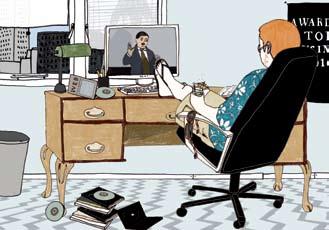
Their mission statement is: “Video training that respects your time, your intelligence and your budget”.
The global economic slowdown has encouraged companies to use the latest technologies for corporate training, rather than the traditional long-haul conference.
Excessive travel and accommodation spending have dried up, but the need for training has not, and technologydriven teaching methods have flowed into the vacuum, offering cost-effective flexibility.
Cisco Systems has set up an online learning programme, Education Management System, which provides extensive training in leadership and management areas, as well as technological and engineering matters, for all its staff. Aravind Sitaraman, managing director of Cisco Development, India, said: “The key attraction of this system is that it allows employees to become aware of various options and plan their learning as they wish”.
McKinsey, Philips Electronics and Johnson & Johnson all use 3D computer games to hire and train employees. They may not be as sophisticated
The eLearning Guild, looking at the design and management of e-learning tools in business, government and education, found that in the financial and banking industries, the level of people using games for work had increased from 33% to 40%, over the past nine months.
Since 2000, McKinsey’s German headquarters has run a computer game called CEO of the Future, to find new talent. In 2007, 5,000 managers and students, worldwide, were challenged to set up a European insurance company in Korea, or maybe launch a drug made from GM fruit.
Kantola Productions, was set up in 1985, by psychologist, Steve Kantola, in San Francisco, and produces a huge range of business training videos, with human resource titles such as; Sexual Harrassment, A Commonsense approach, The Stanford Guide to Financial Statements and Performance Appraisals: Getting Results
Kantola say they use dramatic-format videos with professional actors to show ‘real-world business situations’ and how to implement effective methods, resulting in fast, easy-learning techniques, that facilitate positive change.
[W cisco.com estateagencyacademy.co.uk fawltjsite.com jnj.com kantola.com mckinsey.com microsoft.com philips.com]
Two years ago, Peter Knight, the author of HEMP (The Highly Effective Marketing Plan), set up the Estate Agent Academy to provide online training for estate agents. Knight says: “There is huge demand for this service and we will broaden our offer prior to expanding into other sectors”.
He says: “Online video training is very cost effective... It does not replace live events or one-on-one coaching and should be seen as part of the mix, rather than a panacea for all training and personal development”.
He says the medium is secondary to the message and online video will only work if the content is good.

Knight says: “Once we have developed our offering comprehensively, we will turn our attention to other sectors and repeat the formula. We will not offer generic videos for all sectors, we want to address a specific industry with relevant content”.
Business training videos are not for the negative in outlook, nor for the impoverished in pocket, most costing thousands of dollars, but the scene seems to be set for producers of positivity to quickly make bespoke little nuggets of effectiveness that will inspire and galvanise worldwide workforces without any messy human interactions.
If you don’t fancy sending your workforce to some exotic location for a bit of team-bonding and don’t like the idea of forking out on a bespoke or off-the-peg training video, you could supply some drinks and nibbles and get everyone to watch Jack Nicholson in the filmWolf
21 t ws m — #3.10
•
Illustration by Hanna Melin, London, UK
Coaching Mentoring
By JAN NORTHUP
TODAY THE AGE DOESN’T MATTER ANYMORE; it’s the experience and knowledge that count and make the perfect mentor. Let’s see who a mentor is and how everyone in a company can profit from his expertise.
Reinventing oneself

When Odysseus, King of Ithaca, went to fight in the Trojan War, he entrusted his friend, Mentor, with the education of his son, Telemachus. Mentor’s task was to educate, train, and develop the youngster to fulfill his birthright and become king. While organizations may not be preparing employees to become “king” (or “queen”), they clearly understand the importance of preparing future leaders and being recognized as learning organizations. A learning organization values its workforce as its Number one resource and refuses to be compromised by the competition. What is Mentoring?, What is a Mentor? , Why is a mentor important?, Who benefits? The responses of these questions are making an impact on the way organizations are doing business. Organizations are discovering that the workplace is changing at such a rapid pace, that they must be ready with the technology and the talent to meet these changes or they will be left in the dust by their competition.

WHAT IS MENTORING?
Mentoring is a series of processes whereby employees with more knowledge help and guide those with less experience. Mentoring is an active and sincere effort designed to unleash the full potential of an individual through the development of Knowledge, Skills and Organizational insight. Supervisory mentoring is the natural personnel development based on needs observed and addressed by the supervisor. Informal mentoring is when one individual helps another with a specific skill or knowledge area and is infrequent or a one-time event. Spontaneous mentoring is a moment when a new set of in-
The payoff of investing in a protégé. As the owner of a growing business, I decided to hire and mentor an operations manager so I could travel to client locations and be assured that everything would run smoothly in my absence and, to also have some personal time. John, learned quickly, and followed my every example of client marketing, servicing and retention. Then, the unthinkable happened. John quit and started a competing business! First, I was mortified – then angry – then proud of his success.
Mentoring: a great tool for professional growth. Patty Smith, a manager of an international bank, was seeking career advancement. She had been working for several years but had not been able to have a supervisory position even though she applied for every position available. As she went through the mentoring program, she was able to identify her strengths and skill areas that she needed to strengthen, and her confidence reached a new level. Patty also learned more about the political workings of the organization and the requirements for moving up. Shortly after that, she was offered another position with more opportunities for growth.
formation is gained without pre-planning on the part of the teacher or the learner. It does, however, have significant and lasting impact on the way the learner moves forward with the knowledge. Role model mentoring is related more to the professionalism, communications and personnel interaction that are observed by another. These characteristics are integrated into one’s own attitudes and behaviors about the workplace and co-workers. Facilitated mentoring moves the mentoring relationship from the informal to the formal. It takes the key elements of solid relationship building and combines them with a strategically planned design for empowering employees.
WHAT IS A MENTOR?
A mentor is someone who offers the wisdom of his/her experience. A mentor helps someone learn something the learner would otherwise have learned less well, more slowly, or not at all.
t ws m — #3.10 23
[W organizationalstrategist.com]
Illustration by Peter Arkle, New York, USA
Performance ‘Head chopper’ specialists
By KAREN AND ANEIL MISHRA
WE HAVE BEEN ADVOCATING FOR EFFECTIVE DOWNSIzING STRATEGIES for almost two decades, arguing that firms who treat their employees fairly, and with compassion and openness during the process of laying them off, will end up better trusted by both those who leave and those who stay. We advocate for transparency during the downsizing process, open communication at all levels of management, and transmitting a hopeful attitude for the future, for both those who leave and those who stay.
Effects of downsizing


The writers of Up in the Air obviously did not read any of our research or institute any of the best practices we advocate. Then, again, most corporations doing the actual downsizing these days don’t follow experts’ advice, either. The movie Up in the Air stars George Clooney as Ryan Bingham. He works for Omaha, Nebraskabased Career Transition Counseling, a fictional firm that specializes in providing corporate downsizing services for companies that don’t want to fire their employees themselves. Although the film and characters are fictional, there are many realistic aspects. The film provides several lessons that are consistent with our own experience as researchers and consultants who have studied downsizing for the past two decades.
EMOTIONS THAT GO THROUGH THE PROCESS
Part of the realism comes from the fact that director Jason Reitman cast several real downsizing victims to play those who lose their jobs during the course of the film, and the emotions that they convey are those we have found in our own research: anger, fear, cynicism, disgust, and distrust. What is missing from almost all of the downsizing victims is the hope that their lives will somehow become better as a result of having to find jobs somewhere else. We are neither surprised at the bleakness of these victims’ reactions, nor of the overall despair of the film. This is because Ryan Bingham and his colleagues went about their downsizings without resorting to any of the methods that we and other researchers have exhorted managers and com-
01 Natalie Keener listens as Ryan Bingham (actor George Clooney) prepares to fire someone

02 Natalie Keener (actress Anna Kendrick) tries to reduce her luggage at the airport before leaving on a business trip with Ryan Bingham.
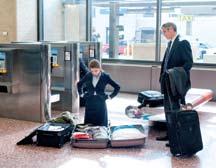
panies to use if they are to improve the efficiency and effectiveness that is the goal of their downsizing efforts. When Ryan says during the film “we are sharks not swans”, he is exhorting others to be fast change agents but without equipping them with any of the necessary tools to be such. The downsizing methods depicted in the film are inherently impersonal and cannot possibly convey any of the compassion or openness we advocate. They cannot express regret or responsibility—in fact, Ryan specifically told Natalie “never to express regret”. Based on our ongoing research, we argue that a manager from the employee’s organization should be the one to layoff the employee face to face. This because it sustains trust and loyalty even among those who lose their jobs.
PERSONAL RESPONSABILITY
As an example of one company that we have been following for more than a decade, we have found that President Ted Castle of Rhino Foods in Vermont is one of those compelling leaders who is willing to take personal responsibility for any downsizing that has to be done. As a result of Castle’s courage and compassion, employees who lose their jobs at his company are willing to leave their new jobs at other companies to return to Rhino Foods when business conditions improve. Given that Rhino Foods is in the highly cyclical food business, Ted has had to downsize his firm more than once. Nevertheless, because hehas been transparent in showing the financial reasons for the downsizing, and
24 t ws m — #3.10
[W ilo.org lhh.com rhinofoods.com theupintheairmovie.com trainingperformance.com ]
01 02
04 Airport scene at the end of the movie: Ryan Bingham (actor George Clooney) thinks about his life wondering if this is truly the life (and job) he wants.

because he has worked hard to help downsizing victims find meaningful employment elsewhere, he is able to engender strong loyalty not only among the downsizing survivors, but also among the victims as well.
Ryan does provide a bit of hope to one victim, when he notices how this employee has always had an interest in becoming a chef, but never pursued that career. Ryan is able to help this downsizing victim see the possibility that there is a future outside the corporate world, and that this can be a source of hope for him, however small. We think this is a good approach, and one he should have taken the time to do with all of the victims.
IMPORTANCE OF TRAINING
We have also long advocated for better training for front-line managers who have to implement the layoffs. Many times, they are thrown into a room with their friends and colleagues with nothing more than a list of who they will have to layoff, and no training on how to deliver the bad news, or how to handle the range of emotions they are about to encounter. We believe that character of Natalie (played by Anna Kendrick) is in many ways a realistic portrayal of what those managers will feel, especially if they have not had previous experience firing people who are not being fired for poor performance. Natalie is initially quite detached, and uses the scripted information that she is supposed to convey to the downsizing victims as though she really believes it. Once she begins accompanying Ryan to give the bad news face-to-face rather than across a video connection, the victims’ unscripted reactions unnerve her. Their responses force Natalie to confront the reality of what she has been asked to do. As she progresses in her job, however, she becomes hardened to it, as Ryan has, as a result of years of giving horrible news to countless downsizing victims. It is only at the end of the film, when the results of their downsizing messages turn even more tragic for one victim, that Natalie rediscovers her humanity and chooses another path for herself.
While downsizing is never the best first option, it would be handled more humanely if managers were trained to provide compassion, if they made sure to be more closely involved in the communication process, and provided their employees with hope for the future.
WHY IS MENTORING IMPORTANT?
Management faces the never-ending challenge of responding to changes while maintaining industry integrity. Cutting-edge organizations have found that facilitated mentoring is a mechanism for rejuvenating itself from within and preparing the workforce for the challenges of tomorrow. No longer will people happen into jobs. Advancement by seniority or obligation is replaced with advancement by skill, knowledge and organizational savvy.
WHO BENEFITS FROM MENTORING? EVERYONE !!
For the Protégé
• Improved performance
• Career guidance assistance
• More realistic career goals, strategies and options
• Increased visibility
• Greater understanding of the organization, its culture and values
• Access to a role model
• Opportunities to participate in challenging developmental assignments
• Encouraged growth beyond usual expectations
For the Mentor
• New perspectives
• Sharpened leadership and interpersonal skills
• Expanded business contacts

• Greater appreciation of workforce perspectives
• Personal satisfaction in helping protégé
• Docemur Doscendo: he who teaches, learns
For the Organization
• Highly skilled and professional workforce
• Enhanced leadership potential
• Retention of “corporate memory”
• Improved transfer of knowledge and skills
• Tool for recruitment and succession planning
• Improved flow or organizational information and sharing
Let me stress that a formalized or facilitated mentoring program is not a training event but rather a long-term process. Mentoring employees is no longer just a ‘nice thing’ to do, but is key to building a solid foundation for change, transitions, growth, and innovation.
Jan Northup, President of Management Training, is an author, speaker and organizational strategist
25 t ws m — #3.10
•
03 Ryan Bingham and Alex Goran (actress Vera Farmiga) accidently meet at airport hotel bar during their respective business trips
03
04
Developed
Developing
Total -10.0
0.0 10.0 20.0 30.0 40.0 50.0
Unemployment Percentage change over the same period of the previous year 26 February 2010. ILO Department of Statistics on-line statistical database LABORSTA at http://laborsta.ilo.org.
countries
countries
Jun08Jul08Aug08Sep08Oct08Nov08Dec08Jan09Febr09Mar09Apr09May09Jun09Jul09Aug09Sep09Oct09Nov09Dec09
By RUY SHIOzAWA
is
in a period such
the
I reward you without money
Imagine you are applying for an important job at a major company. You have been through several interviews. This is your final interview, with the Global CEO. After a one and a half hour Q&A session, talking about the world situation and market opportunities, you have one last question to answer: “Your team has attained very important results, a special achievement, and you would like to give it proper recognition. The best way to do that would be to give them a nice financial reward, right”? You answer: “Yes” and, to your great disappointment, the CEO apologizes politely and lets you know that you have not been selected.
FIRST MANAGERS’S INVOLVEMENT
Every year, this company takes part in the ‘Best Companies to Work For’ survey. In the last three years, it has been ranked among the Best in its country. However, the company has put a lot of effort into reaching that position. Employees were constantly dissatisfied and evaluation rates would not improve, even with pay rises or better benefits. It was only when the CEO finally decided to become personally engaged in building a great place to work that he realized, after analyzing survey results, that employees were very suspicious of anything that came from top management. Even pay rises didn’t seem like sincere recognition, but a way to ‘buy off’ employees, making them overlook objectionable everyday situations in the workplace.

He, then, started to try and listen to people, to understand what those
problems were. He found out that many of the employees saw their superiors as slave drivers, who treated them disrespectfully. He realized that many of them had never been trained, by the company, to fulfill their jobs. They were not genuinely interested in the people, but in whether they had carried out their tasks or not. A simple ‘thank you’ was unheard of, even if a team had spent all night working to finish a report requested by the Management.
SECOND COMMUNICATION AND TRAINING
Change began to be implemented throughout the company. Survey results were shared with everyone, pointing out the strong points and employees’ major concerns. Result presentation and analysis meetings became extremely important, with no set time to finish. New communication channels were established between employees and the top management. Leadership in all areas, helped by the CEO himself, started devising action plans to improve the workplace. Supervisors were instructed to say “good morning” and ask about employees and their families before discussing the day’s activities, with a view to being supportive to people’s work and not just demanding results.
THIRD AMAzING RESULTS
The internal climate survey, on which all of these initiatives are based, went from annual to quarterly, as it has become a priority supporting pillar within the company’s management
model. A leadership development program has been implemented. This includes all current and future leaders. Many, but not the CEO, were surprised to see company results begin to improve significantly. Managers noticed that, since the improvements in the workplace, their employees have been giving their best. People are really working as a team or a family. Turnover has dropped considerably and people are clearly proud to work for a company that respects them, above anything else. The level of employee satisfaction has also improved remarkably. It goes without saying that productivity has increased and, as a result, so have earnings and profit.
Company performance has improved as a whole, which has made it possible to improuve compensation and give fantastic bonuses to everyone – not just a few top executives. Nobody is complaining, of course! So, in your next interview, make sure you say you believe in investing in people and the workplace. Do that and a better salary will come as a result. All the best!
27 Attachment
and pride Money bonuses are important
[W greatplacetowork.com.br] t ws m — #3.10
EMPLOYEES WANT TO BE PROUD OF WORkING FOR A COMPANY THAT RESPECTS THEM. This
why,
as
current one, when many companies are short of money, for a short time bonuses can be replaced by an environment with excellent work, managers who listen to people, and say ‘thank you’ at the end of the day.
•
Ruy Shiozawa, is the CEO at the Great Place to Work Institute® Brazil
Erik Buell
a modern
one of
A dreamer in the realm of HD
Erik Buell (born in 1950 in Pittsburgh, PA) grew up on a farm in Gibsonia and learned to work on machinery at a young age. In his teens, Buell took up motorcycling. His first ride was on an Italian-made Parilla 90cc moped. Buell raced motocross before becoming interested in road racing in his early 20s. He became an avid part-time road racer and did his racing astride a Ducati in the AMA ‘Superbike’ class and a Yamaha TZ750 in ‘Formula One’, despite the aging race program at Yamaha. After receiving his degree in engineering in 1979, Buell flew himself to Milwaukee, where he got a job at HarleyDavidson.
THE ExPERIENCE WITH BUELL MOTORCYCLE COMPANY
“If you want to improve and achieve new goals, fight for them first within the company by listening to the voices that have been excluded, those groups who are not happy and have been asking for change”, he says. While working for Harley-Davidson, Buell’s road racing hobby was slowed down. Additionally, as Harley-Davidson went through some hard times in the early 1980s, he didn’t feel right racing a Yamaha or a Ducati motorcycle. “My dream was to build the perfect racing motorbike made entirely in USA. In addition, I was commited to creating jobs during a period of deep crisis in all the US markets”. In 1982 Buell purchased the entire stock of spare engines, parts, drawings, and the rights to produce and sell the engine of a the small, privately held general-purpose engine maker, Barton (based in Great Britain). Barton’s
01 Erik Buell and Tim Mlinar machinist, discussing machining triple clamp for lighter weight

02 Erik Buell and kemp Asbeck race technician with the 1125R DSB version.
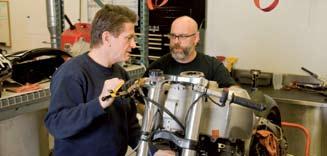
motorbike was very poorly made, using cheap materials and an engine that was plagued by gremlins to the point of being unusable. With Buell’s engineering background, he felt that he could refine the weak points using his own designs and make the engine work for him. Slowly, as parts failed he re-engineered them to increase reliability, and in many cases saw performance gains with his modifications. Buell’s passion to develop a perfect racing engine spurred him to leave H-D and strike out on his own.
A people centered philosophy: “work with people you like and with whom you share common goals” says Erik Buell. He also firmly believes that it is important to listen to what consumers want and not just to think about the company’s business. In the 1990s, Buell restyled his production house to become the ‘Buell Motorcycle Company’ in which Harley-Davidson took a 51 percent share. Harley-Da-
28 t ws m — #3.10
People Heroic managers
HUMILITY, COURAGE AND ABOVE ALL PASSION are what we found in East Troy, about 35 miles from Milwaukee (USA).
is
knight,
the pioneers of todays motorcycle race technology, who in 2002 was inducted into the AMA Motorcycle Hall of Fame Museum located near Columbus, Ohio. After twenty years of partnership with worldwide leading company Harley-Davidson, he is now owner of Erik Buell Racing, is old dream.
INSIDE THE MOTORBIkE kINGDOM: HARLEY-DAVIDSON
01 02
Photographies by Timothy zwicky, Millwaukee, USA
vidson bought complete control of Buell Motorcycle in 2003, and distributed all products through selected Harley-Davidson dealerships. Erik Buell remained responsible for all the engineering and designs. “My desire was to enter H-D into racing market; in short, to create a sort of dual market for the famous motorcycle house” he states. However, on October 15, 2009, Harley- Davidson announced that all production of Buell motorcycles would cease on October 30, 2009.
ERIk BUELL RACING
For Erik Buell, being successful means always interacting with other people; it is not possible to achieve any kind of success if we live only inside ourselves. In November 2009, Buell launched Erik Buell Racing, which will continue to produce raceonly motorcycles. “It is a completely new company even though it was build on experience from H-D”. he says. The closing of Buell production by H-D was a profound shock for Erik Buell. “I was devastated, hon-
estly I wasn’t thinking only about myself but especially of all the employees and the thousands of customers” The new company in a way was born because he started thinking about his friends, his collaborators, and how to maintain both the passion and these relationships. The development of this small new company in the arena of racing motorcycles will not be easy, because there are
advice to give: “anybody with a mature career has made mistakes”, he says,”therefore there is nothing to forgive”. Erik Buell may have lost many battles but is stubborn about winning the war to achieve his dream. Because he well knows that, without a challenge, human beings lose their capacity for great thoughts and feelings.
Buell’s values
• Encourage intellectual curiosity
• Continue to interact with other people and build strong relationships.
• Be fair
• Listen to what the consumers want and don’t just think about the company’s business.
• Listen inside the company to those groups that are not happy and have been asking for change
• keep your promises
• Maintain a very flat structure, avoiding a hierarchy that is too vertical.

• Tell the truth
• Work with people you like and with whom you share common goals.
03 Standing L to R: Henry Duga friend, Bill Malzewski technician, Tony Neuburg lead engine technician, Tim Mlinar machinist, Tish Buell Erik’s wife, Erik Buell, kemp Asbeck race technician, kurt Hanson fabricator. Seated L to R: Michael Richter and John Fox engineers
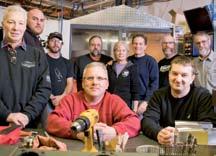
04 Erik Buell

so many big companies with a lot of money to compete with. “I think that we can bring something new to this business. People are now complaining about the amount of money being spent in this arena and I’m sure that a small company like ours can breathe new life into the field”. There have been ups and downs, and some efforts have failed, but all these experiences have still produced growth. All of Buell’s experiences share one common denominator: the blind passion for the work. Erik Buell has no
The first new motorcycle from Erik Buell Racing
The 1190RR is based on the 1125R and 1125RR, and brings engine displacement close to the AMA American Superbike (ASB) class limit for twins and the WSB limit overall. Although it is not currently approved for AMA ASB class racing, this bike can be raced in many classes around the world and should add new excitement racing against other premium street-based twin roadracers. The 1190RR models are constructed from new 1125Rs with a complete kit of Superbike level components. Engines are completely disassembled and blueprinted, with top-shelf internal parts added to deliver reliable performance at the extreme rev ranges required for a twincylinder bike to compete at these power levels.

03 04 t ws m — #3.10 [W erikbuellracing.com]
By PINA DRASKOVICH
29
•
People Unusual jobs
 By FRANCESCO MOCELLIN
By FRANCESCO MOCELLIN
WHEN WE THINk OF THE CIRCUS, WE THINk OF ITS BEING A WAY OF LIFE more than a form of entertainment. Indeed, the circus is more an existential condition than a substance and artistic enterprise. Observed more closely, the world of the circus reveals surprising aspects that make it a highly-diverse reality

Ringing the changes
VOCATIONAL TRAINING
The children of circus artists and directors tend to remain in the environment, following in the footsteps of their parents and relatives, and learning the tools for their future work, whether this will be in the ring or in management. Until the early-1980s in Western Europe, only a few people not related to a long-term circus family were to be found in this environment. These outsiders (‘fermo’ in the language of Gypsy origin) had usually married into a circus family. The situation was, though, completely different in the old Soviet-block countries with the nationalization of all enterprises and the creation of a State Circus (Soyuzgoscirk 1919).
In 1927 the School of the Arts of Moscow Circus was created. The school offered four-year courses in circus techniques and disciplines. The school helped boost high-quality shows that served a vast internal market, and occasionally also toured in Europe. The artists were state-employees.
From the mid-1980s, even some Western European countries opened training institutes for circus artists.
OTHER SCHOOLS
This phenomenon originated from the crisis of the great names of the German, English, and French tradition, and was designed to revitalize the market. The first nation to kick off this trend was France where Annie Fratellini, a French circus clown and film actress, opened a school in Paris. This still survives and is keyed on strict classical dictates.
In 1985, the Centre National des Arts du Cirque was founded in Chalonsen-Champagne, in the heart of the country. One could say that the circus school was the nation’s forerunner for all those inspired by the ‘Nouveau Cirque’. Le Centre National des Arts du Cirque is still operating in the same direction today. In 1988, Egidio Palmiri, founded the Circus Academy in Verona, Italy. This still trains young talents who find work in circus rings and elsewhere, around the world. Over the past twenty years, circus schools have developed along different lines. Some offer general artist training. Others are specialized in workshops; others yet are reserved for amateurs.
NORTH AMERICA
The U.S. giants, Ringling Bros. and Barnum & Bailey Circus—controlled by the Kenneth Feld family—have sponsored a sort of clown academy. Dubbed ‘Clown Alley’, its graduates take part in the circus’ annual production. Circus schools outside the USA have always been characterized


by being private and being supported by sponsors.
MONTREAL
The real training centre is Montreal (Canada) which is the reference for the entire North American Region and it is the headquarters of the Cirque du Soleil. The city presents itself as one of the most dynamic locations in terms of circus culture. The influence of the company directed by Guy Laliberté has produced the prestigious Ecole du Cirque that has trained many artists who have found work in Europe, in addition to the varied ‘Tohu’ a multipurpose facility created by a joint venture between sponsors and institutions.
CENTRAL AND EASTERN EUROPE
By the time the USSR fell, state organizations had declined in importance, without disappearing altogether. Most of the artists became independent, generating a significant increase of supply in the circus market.
CHINA
In the last decade, the Chinese market has also absorbed an increasingly large number of artists and companies. Traditionally organized in ‘acrobatic circus associations’ mainly based in regional areas, nowadays China is perhaps the only country capable of supply-
30 t ws m — #3.10
Illustrations by Yihsin Wu, Taipei City, Taiwan
ing large crews that present high-level performances at competitive prices.
THE CIRCUS AS AN ENTERPRISE

From this overview, we can see how the circus is much more vibrant and stable than we might have expected. The mechanisms of reproduction of circus skills have become refined and diversified in the recent decades. The limit of such mechanisms is perhaps that of focusing attention on artistic training without properly considering the people related to management and marketing that are absolutely indispensable in the circus production. The near future will probably see a widening of training in this direction.
BUSINESS MODEL
The prevailing model is family-oriented, with individual family members taking responsibility for specific tasks. This operational model is still giving excellent results in several cases. There is, however, a growing need to combine the experience of the classic circus tradition with a more managerial point of view that is keyed on marketing. The ‘Cirque du Soleil’ rose from nothing, and has been the largest live entertainment company for twenty-five years with eleven tour productions and eight residential shows. Even the typical image of the circus as a year-round touring company has changed. Galas and oneoff, or seasonal, events are becoming more popular. These include Christmas dinner shows that are typical in Northern Europe.
ENTERTAINMENT PARkS
Many circus companies combine their original activity with managing amusement parks and zoos.

MONACO – THE CIRCUS CAPITAL
The phenomenon of the Circus festival began in 1974 in Monaco, thanks to the enthusiasm of Prince Rainier III. The festival has become a fertile place for making contacts for both staff and artists.
Today, the Festival of Montecarlo is the circus show by definition and is universally known thanks to the Grimaldi family.
The Festival of Montecarlo represents the second largest income for the Principality after the Formula One Grand Prix. •
[W academie-fratellini.com cnac.fr ringling.com cirquedusoleil.com montecarlofestivals.com]
t ws m — #3.10
31
People The Best Job in the World
By RAQUEL

IN 2009, TOURISM QUEENSLAND LAUNCHED A CONTEST WITH THE PRIzE BEING ‘THE BEST JOB IN THE WORLD’. Over 34,000 people from more than 200 countries applied for this unique position. Ben Southall, a 34-year-old UK charity fundraiser, was chosen. During the six months duration of his posting, Ben spent his time exploring the islands of the Great Barrier Reef, and reporting on his travel experiences by means of a blog.


The island dream

We met Ben after his six months experience as caretaker of Hamilton Island.
What were your expectations, when you won this job? Working as the Island Caretaker gave me more new experiences than I have ever had before in my life, and I honestly loved every minute of it. Having read through the job specification as soon as the advert for the position went out, I knew that it would be more than just a six-month holiday. It was a serious position, and there was a large amount of work to be done by the prospective employee! However the type of work would be fun and exciting: the envy of those around the world. Exactly what it was supposed to do: make people jealous, and entice them to book a holiday in Queensland to have their very own adventures.
What was it like to live on an island for six months with your girlfriend? Spending six months living on Hamilton Island was like a dream come true. Waking up in the morning, and looking out over the Coral Sea from the balcony was an experience that will live with me forever. We visited 62 islands over the six-month contract! We felt like we were living like Robinson Crusoe. The Whitsundays are all about fun and life on the water.
Could you please describe your tasks: what did you do exactly? The tasks that my role involved weren’t really the same as those advertised. The four tasks were ‘feeding the fish’, ‘watching the whales’, ‘delivering the mail’ and ‘writing a weekly blog’! There was so much more than this. But I took each
01 Up Hill Inlet Whitsunday Island 02 Kayaking Whitsunday Island (CR: Tourism Queensland)


Hamilton

of the tasks I was given as a new challenge, whether it was presenting the series for National Geographic or running the Gold Coast marathon.
You were stung by a deadly jellyfish, and your life was at risk. This was a very unfortunate situation, which could have been avoided if I’d have followed my own instructions! Wearing a stinger suit at this time of year is essential in the tropics, since there can be jellyfish in the water. When I went out for a jet ski over the Christmas period, I failed to put one on. As I left the water, I felt a small bee-like sting on my left forearm. I knew something had got me. It took 30 minutes for the effects to start to take place: I felt a tingly feeling in my feet and hands. The back pain that followed was pretty uncomfortable and I went straight to the medical centre on Hamilton Island to seek guidance. The doctor there recognised my symptoms as Irukandji Syndrome and gave me the required treatment. After a few
uncomfortable hours, I was discharged; The next day, I felt fine again—in fact, I went for a 10km run! That said, it was not an experience to be repeated.
...And now what about the job after the Best Job in the World? We’ll be keeping the pace of the campaign going as I head around the planet to talk to the media, and give presentations to the trade about the job, the experience, and the opportunities in Queensland for people considering holidaying there. My new title becomes Global Tourism Ambassador. In my downtime, I will be continuing to travel throughout the state to discover more about what’s on offer. Further down the line, I am planning another big adventure: I intend kayaking the length of the Great Barrier Reef, all 2300km of it, to raise awareness about the reef, educate people around the world, and also raise money for a number of charities.
The adventure continues ...
Island Reef #1 Palm Bungalow Reef #3 Reef #4 Reef #5 Reef #2
t ws m — #3.10 33 • [W bestjobben.com islandreefjob.com queenslandholidays.com.au tq.com.au]
01 02
RECIPROCAL
RECOGNITION OF
REPUTATION, guest speaker agencies keep in close touch
the ideal speaker with respect to theme or activity. There is a move away from the theoretical and purely motivational, towards topics related to the speakers’ actual experience.
Let me tell you a story
SELECTING THE RIGHT PERSON
The National Speakers Bureau was the first of its kind in Chicago. They represent a variety of speakers divided per sectors so as to match the right speaker to each event: Jim Abbott, famed Major League baseball player, Robert Ballard ocean explorer and Howard Putnam formerly CEO Southwest Airlines. Talking about how their clients choose a guest speaker, Brian Palmer, the NSB’s President reports: “these companies usually have a name. We ask lots of questions to help them refine what they’re looking for and provide a basis for a decision”. Among the speakers who attract most interest, he lists Sully Sullenberger, the pilot who made that safe landing on the Hudson River in New York City: “he is asked about a good deal”.
WHO ENGAGES SPEAkERS
Carlton S. Sedgeley, President of Royce Carlton, a NY-based speaker agency, says that their clients are: “those producing events for various companies, colleges and universities, forums and clubs, regional non-profit groups and hospitals”. Then, he goes on to explain what they do “Usually the clients don’t need advice because they already have a speaker in mind. What we do is give a series of suggested topics related to that speaker”. As to how clients decide on a particular speaker, he says that what counts most is “the visibility of the person that clients know we represent” and, when he’s asked how far clients go to get the speaker they want, expands on visibility.
FEES
At Eagles Talent (NJ), the speakers are allocated to three categories.
01 02
There are Key speakers – as in the case of the international best-selling author and expert in competitive business communication Beau Toskich. Then there are Sports Stars (such as the NBA Legend Larry Bird and World No. 1 Tennis Icon André Agassi). The third category are the Entertainers (including the Queen of Swing Holli Carroll). There are also other subcategories based on the talent or specialty of each speaker. This breakdown helps clients navigate the portfolio. The fees range from US$5k for Ed Hearn, the former New York Mets catcher to US$100k and above.

THE MOST REQUESTED SPEAkERS
Bill Lee, Vice President of Eagles Talent, continues “My sense is the trend is moving away from purely motivational speakers and towards leadership speakers, business thought leaders, and inspirational speakers who inspire people through what they have accomplished whether it is a mountain climber or very successful entrepreneur”.

RELATIONSHIP BEETWEN AGENCY AND CUSTOMERS
Michael Frick, President and Founder of Speakers Platform “We send our clients a pre-event questionnaire to help us determine the best fit for their particular event needs”. As an example, he explains “One of the nation’s leading credit card companies called Speakers Platform wanting speakers for a leadership event. They needed three speakers to do two presentations each, within a tight budget. So, all three speakers needed to reside within the event location’s state and negotiations where needed. Their agent tracked down three ideal candidates: Nikki Stone, Mike Schlappi and Henry Marsh. The event was postponed for over a year, but their Speakers Platform agent periodically kept the client updated on the speakers’ availability. Once the client was able to hold their event, he facilitated a smooth booking process. •
35 Communication Speaking volumes
[W eaglestalent.com nationalspeakers.com roycecarlton.com speaking.com ] t ws m — #3.10
IN A RELATIONSHIP BASED ON TRUST AND
with their clients to engage
01 Actress Glenn Close represented by Royce Carlton
PC
02 Famed Major League Baseball Player Jim Abbott represented by National speakers
Internal communication Signage trends
 By GIORGIO TEDESCHI
By GIORGIO TEDESCHI
SIGNAGE SYSTEMS
ARE BECOMING MORE ENVIRONMENTALLY-AWARE

; they are also becoming more versatile in graphic, and even digital, terms, the better to integrate signage with our ever-changing communication needs. Providing directions within companies showing people how to get in and also how to get out is the creative business of a number of highly-specialist companies.
Wayfinding communication

10 steps for signage project
implementation 01 Corporate identity study 02 Development of prototypes 03 Production engineering 04 Project planning 05 On- site visits by technicians 06 Authorizations 07 Production 08 Installation 09 Project assessment 10 After-sales service
In-company signage helps manage the flow of people who come and go within that company’s buildings: employees, vendors and clients, as well as visitors. CiCrespi, founded in 1910, is in a strong alliance with the Danish company Modulex, founded in 1963. Their network consists of companies from 41 countries around the world. CiCrespi-Modulex are design and wayfinding specialists, and we visited the them in Denmark.
HOW A PROJECT IS HANDLED
“Where there is a coming together of people, there is signage” says Pernille Walentin Jensen, Sales Manage of Modulex, France. “The project begins with a client status analysis, flow analysis, information priority definition, graphic development, colors, and materials. The implementation of a signage project starts with a collaboration between architects and graphic artists, moves on to installation, and continues with maintenance, which is ongoin. In av-
“The planning and production cycle takes about six years” adds Pernille Walentin Jensen. In the last five years, costs for these kinds of projects have fallen by about 30%, “thanks to the simplification of basic components, such as materials, finishes, and accessories”.
erage it takes approximately 1 year to develop a new product. Projects that consist mainly of new developed products can take from 1-6 years depending on the size of the project, the client’s decision-making process, etc”.
STYLE AND FINISHES
Michele Bonello, CiCrespi’s Managing Director in Italy, remembers his first project in 1987, the Pinacoteca of Brera in Milan: “a project which led to the publication of the book L’arte della segnaletica”, a blend of Italian style and Danish rationalism. Michael Handberg, Graphic Designer at Modulex Denmark, deals with research and development of materials and modular systems. He says that “nowadays, design (extra-fine surfaces) is minimalistic with signal forms tied to
the organic nature of materials. For example, shapes are those of stones, eggs, or drops of water, while materials are recyclable and environmentfriendly, such as grainy wood, bamboo, glass, and Corian”.
ENVIRONMENTAL CARE
Nils Frederik Damsgaard, Senior Designer, has developed studies for the production of low environmental impact signals. The world of signage has just recently graduated to environmental sustainability issues. As well as shape and design (making the most of materials, eliminating those that produce waste, and clash with an integrated system. Examples include street posters, wall posters) topics include new materials.
STATIC OR DIGITAL?
Outdoor signage, such as department name, with directional arrows, and so forth, are usually static. These are the kind of signals that Michele Bonello
36 t ws m — #3.10
01 02
01 Diagram of signage components
02. 03. 04 Allen and Overy a legal office in London; colors and simplicity
05 Grinnel College (USA); innovative digital signage solutions

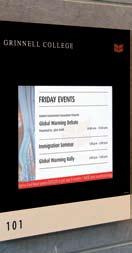
06 Grinnel College (USA); static signage for directions
07 Banca Intesa San Paolo, Milan (Italy)
With colours solution
“
The wayfinding solution had to accomodate high rates of change, and flexibility in the system adopted for naming destinations” says Johnny Nichols Head of Business Services Projects, Allen and Overy, a major international legal practice. Given the scale of the building, the wayfinding design was based on both a grid system and on colour-coded zones. These correspond to the architectural layout, ensuring a logical framework for every journey.
Effective communication through digital signage solutions
Founded in 1846, Grinnell College, located in Grinnell, Iowa (USA), has been named one of the 20 best liberal arts colleges in the country for the past fifteen years by U.S. News & World Report
Static signs (typically direction signs) and digital solutions (for messages that are changeable with time) coexist in the Grinnell College building.

uct with “low maintenance and CO2 production costs.” Obviously, the initial outlay in money terms is higher.
SIGNAGE LIFE SPAN
defines as “lasting in time”. Digital is the new frontier, “it’s about electronic supports that provide information through the use of customized software”. Pernille Walentin Jensen, underlines that “finding the right balance between static and digital has been the tendency in recent years, not least for budgetary reasons. If a classic corporate building signage project in static form costs about 150k euros, the digital version would be around 350k while a mixture of the two might come in at around 230k. The deal is to use digital only where it is really needed”, she says.
LIGHTING
Signage means lighting. For example, the classic “H” for Hilton Hotels, which is currently undergoing a graphic redesign. The key term is low-energy, long-life LED. “If a traditional fluorescent tube lasts 15k hours, a LED lasts three times as long”, says Bonello. Besides we are in the presence of a prod-
A well-made product is designed to last for more than ten years. In reality, the life span is often just four years, this because companies change more than once a decade. This impacts on sector innovation, which must be constant and involves considerable investment on the part of the company. According to Pernille Walentin Jensen’s estimates, a major French hospital with 800 beds, invested a total of 1,126,000 euros between 2003 and 2007. Of this, 75% went in internal and external communication, 12% in installation services, and 13% in maintenance.
HOW WE CAN GET THROUGH TO THE CHINESE
The tendency is to use both languages: English along with the local language, as well as a comprehensive use of pictograms, with these becoming increasingly personalized these days. Michele Bonello, who is fond of pictograms, states that “symbols speak louder than words”.
HOW DOES ONE GET ON IN THIS SECTOR?
An acute sense of esthetics, the ability to synthesize, and an aptitude for team work are career requisites. Professional, families, are a mix of technicians and creative people. The latter come from the world of advertising and graphics, while product developers are engineers. In addition to CiCrespi and Modulex in Europe and in the rest of the world leaders: Asi Sign in the USA, D Line in Denmark, Spendex, Wood&Wood in Australia.
Philips for Banca Intesa San Paolo

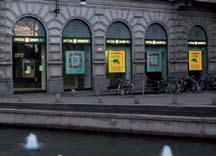
Enrico Pavin, SSI Philips Lighting Business Development Manager, reports that the new LED system for the neon signs of Italy’s secondlargest banking group, guarantees excellent uniformity in terms of brightness paired with low-energy consumption.
[W asisignage.com carlf.com cicrespi.com modulex.dk ralphthemagician.com spandex.com woodandwood.com.au]
t ws m — #3.10 37 •
03 04 05 06 07
By MATTHEW SEMINARA
IN AN ATTEMPT TO AVOID WALL STREET FROM REPEATING THE ACTIONS THAT HAVE BROUGHT ABOUT THE FINANCIAL CRISIS,
President Obama is introducing legislation designed to regulate the financial industry. To Wall Street executives he says: “instead of sending a phalanx of lobbyists to fight this proposal or employing an army of lawyers and accountants to help evade the fee, I suggest you might want to consider simply carrying out your responsibilities”.
The US government’s ideas
President Obama has announced that, as many as fifty financial firms with assets greater than $50 billion, will be charged a tax, termed a ‘Financial Crisis Responsibility Fee’ to help recover some of the U.S. taxpayer-bailout money, as well as attempt to trim the ever growing federal budget deficit. The Obama administration estimates the unrecovered cost of bailout money to be $117 billion. The new fee would recoup this amount within ten to twelve years, and then end. “My commitment is to recover every single dime the American people are owed. And my determination to achieve this goal is only heightened when I see reports of massive profits and obscene bonuses at the very firms who owe their continued existence to the American people-who have not been made whole, and who continue to face real hardship in this recession”, said President Obama.
INTRODUCTION OF THE NEW TAx
The tax would be imposed beginning in June 2010 on such mega-companies as Citigroup, AIG, and Bank of America. Banks and financial institutions that didn’t receive federal funds would also face the tax.
VOLCkER RULE
In addition to the tax, President Obama has proposed the ‘Volcker Rule’. This would stop banks from being allowed to own, invest, or sponsor hedge funds, private equity funds or proprietary trading operations for their own profit. The Volcker Rule-in recognition of the former Federal Reserve chairman, Paul A. Volcker-would limit the size of the largest U.S. banks and prevent financial institutions backed by the U.S. govern-
ment from taking huge risks in speculative investments that contributed to the economic crisis in 2008. Speculative investments would be left to other areas of the financial markets and not the large federally insured commercial banks. “Hedge funds, private equity funds and trading activities unrelated to customer needs and continuing banking relationships should stand on their own, without the subsidies implied by public support depository institutions,” says Volcker. “They are, and should be free to trade, to innovate, to invest–and to fail. Managements, stockholders or partners would be at risk, able to profit handsomely or to fail entirely, as appropriate in a competitive free enterprise system”.
WALL STREET DREAMS ABOUT “OLD DAYS”

While President Obama’s the large scale vision for fair, equitable and responsible financial institutions is noteworthy, Wall Street is livid, yearning for a safe return to the old ‘business as usual’,’too big to fail’ approach. Using tax policy to punish people is a bad idea, JP Morgan Chase CEO Jamie Dimon said. “All businesses tend to pass their costs on to customers”. Opponents of the proposal argue that several banks that would be subject to the tax have already paid back all the bailout money they received. Many go on to insist that the proposal does little to change their business models, and it remains unclear if either proposal would have helped to prevent the economic meltdown. Most economists believe the tax will help to recoup bailout money, but it is not likely to help end excessive executive compensation. A direct tax on excessive Wall Street bonuses would help to discourage such
payments. Great Britain has already proposed a 50% penalty on bank bonuses. Moreover, British Prime Minister Gordon Brown has called for a global tax. It is important, he argues, that the “contribution banks make to society is properly captured.” Prime Minister Brown believes President Obama’s tax is proof that “support is building for international action,” as “people are now prepared to consider the best mechanism by which a levy could be raised.” Likewise, economists also believe that the Volcker Rule can have a positive impact on the economy. Banks would be forced to get back to the more stable,
What the new tax might generate in revenue
Est. annual tax
Citigroup $2,160 mil. JP Morgan Chase 1,956 Bank of America 1,737
Goldman Sachs 1,170
Morgan Stanley 992 MetLife 746
Wells Fargo 578 Bank of NY Mellon 212 State Street 199
U.S. Bancorp 134
PNC Financial Services 99
Northern Trust 71
BB&T Corporation 62
Capital One Financial 61
Sun Trust Banks 54
Regions Financial 50
Hudson City Bancorp 46
Fifth Third Bancorp 30
KeyCorp 28
M&T Bank 27
Comerica 20
Marshall & Ilsley 18 Huntington Bancshares 11 zions Bancorporation 11
[W aig.com bankofamerica.com bnymellon.com citigroup.com goldmansachs.com jpmorganchase.com metlife.com morganstanley.com northerntrust.com pnc.com statestreet.com usbank.com wellsfargo.com]
39 t ws m — #3.10
Legal Reforming Wall Street
In Gaku’s illustration: While dealing with the economic crisis, Obama asks the banking world, which continues to lead the good life, to take charge of their responsibilities
Legal Reforming Wall Street
By CRAIG JOHNSON
Ethics and the workplace
albeit boring, business of lending and deposits, ending speculative and volatile proprietary trading and hedge fund investing. Those opposing the Volcker Rule state that international consensus is still needed, particularly among the nations where multinational financial institutions are based. Of course, Wall Street executives have also questioned the need for the Volcker Rule, believing such limits could cause a number of problems for U.S. banks, including putting them at a competitive disadvantage to their foreign counterparts. And as the old game on Capitol Hill goes, the New York Times has reported that some chief executives are already sending a clear message to elected Democrats in Congress by donating money to the Republican Party to shift the political edge and help influence mid-term elections. “If the President wanted to turn every Democrat on Wall Street into a Republican, he is doing everything right,” said an industry lobbyist.
MEANWHILE, THE ECONOMY IS “SLOWLY WAkING UP”
‘Re-reading’ the past ten years is like reading a war report: the last decade has seen one corporate scandal after another. Enron, WorldCom, Parmalat, Ahold, Washington Mutual, Fannie Mae Corporation, AIG Insurance. The corporate executives of these companies have abused of their power, thus missing the chance to be ethical models for their employees. In the future a renewed commitment to long lasting values should avoid these attitudes which have produced the global economic crisis. We invited Craig E. Johnson, author of Meeting the Ethical Challenges of Leadership and Ethics in the Workplace and Leadership Studies and Director of the Doctor of Business Administration program at George Fox University (Oregon), to speak about what kind of leaders organizations need.
Organizations need leaders who can resist
temptations
twsm: How do you think the corporate world is performing at the moment?
world investors as ‘safe’. When overleveraged borrowers began to default on their loans, the financial system collapsed.
twsm: What are the challenges, then, for today’s corporate leaders?

While the Obama administration’s ambitious proposals attempt to rein in Wall Street, the U.S. economy is slowly recovering, albeit at a modest pace. Now the proposals will be brought to Capital Hill where the U.S. House and Senate will soon vote on the legislation. Reactions on both sides of the political aisle are mixed. What Congress should remember is that, while the stock market is up from March 2009 lows and banks have stabilized, unemployment continues to hover at around 10%, and close to 15% of all Americans have mortgages larger than the value of their home. Over the next two years, the American people will largely determine the political landscape. Our hope is that even Wall Street has learned from the grave lessons of the past, while building for a return to financial strength, economic security and prosperity.
•
Johnson: Corporations are seriously underperforming when it comes to ethics. Consider the current global financial crisis, for example. It was triggered by the United States financial industry’s focus on short-term rewards. Leaders cut ethical corners in pursuit of profits. Unscrupulous mortgage brokers locked homeowners into loans they couldn’t afford. Accountants looked for ways to skirt financial regulations. Investment-rating firms understated the risk posed by subprime mortgages. (In some cases the rating services were paid by the lenders they were evaluating). Wall Street banks, led by executives who received lavish bonuses for quarterly earnings, then created financial derivatives that they marketed to
Johnson: In addition to dealing with the lingering effects of the global recession, leaders must put their organizations on a firm ethical footing. Surveys of large North American corporations reveal that these firms meet legal requirements through adopting codes of ethics, creating systems to register complaints, and hiring ethics officers. However, these formal ethical programs are disconnected or decoupled from most corporate decisions. CEOs rarely discuss ethical topics with their ethics officers or talk about ethics with their employees. Leaders must create ethically driven corporations to replace those that only pay lip service to ethics. Companies with ethical integrity are valuescentered. They recognize that moral considerations should be part of every decision, policy and operation. Siemens International demonstrates how leaders can make ethics central to their corporate cultures. Bribery was ‘business as usual’ at Siemens, where company managers routinely paid kickbacks to win contracts in developing countries.
To root out this corruption, new CEO Peter Loescher announced a zero-tolerance policy for bribery. He and his compliance staff enforced this policy by reminding employees of their ethical obligations, removing half of the management board, and firing guilty workers. Executives at Siemens know that eliminating corruption is just the first step. Their ultimate goal is creating an ethical company culture where employees are driven by values rather than by the rulebook.
Illustration by Gaku Nakagawa, Kyoto, Japan [W ahold.com aig.com enron.com fanniemae.com parmalat.com siemens.com wamu.net worldcomgroup.com]
t ws m — #3.10 41
•
By PAOLO VALENTINO
MEETING WITH HIS ECONOMIC ADVISERS AT THE WHITE HOUSE, some time during November 2009, to discuss measures for stimulating employment, President Obama realised that everyone seemed to be in agreement. At which point, he called for a Time Out. Everyone was to go back to their offices for 30 minutes. Then the meeting would resume, with everyone putting forward at least one different point of view
The ‘review culture’
Recounting the incident, Larry Summers, the White House Economics guru remarked that Obama wants his advisers to think differently from each other, and to be prepared to defend their views. The president is, he added, very careful to identify those who have not spoken during a debate, and to ask them if their view diverges from that of the majority.
In January, at a meeting in the White House Situation Room, Obama and the National Security Council were discussing the US Secret Service’s failure to put together the information they had to arrest Umar Faruk Abdulmutallab, the Christmas Bomber, well before his attempt to blow up Northwest Airlines Flight 253.
That the president might be furiously angry seemed more than reasonable. Obama’s comment was limited to saying that “This was a screw up that could have been disastrous”. There followed a cool and dispassionate review of the facts, which was a prelude to the president’s taking responsibility for what happened. New and more stringent security measures for passenger flights were also announced. The whole closely-focused and rhetoric-free.
GATHERING INFORMATION ALSO FROM UNUSUAL INSTRUMENTS
Another example of the Obama management style was revealed during one of the long sessions when strategic policy in Afghanistan was being revised.
Two military experts were deep in debate regarding a recent report on PostTraumatic Stress Disorder, when the president jumped in. He had obviously read the report. No-one recalled having sent it to him, neither had he been briefed on the subject. This shows that,
despite the wealth of information that arrives in the Oval Office every day, Obama also seeks out his own sources. He is a voracious reader, and has access to the internet on his desk. Meanwhile, his Blackberry allows him to send and receive personal email. (It is also true to say that, among his reading is Sports Illustrated, and he follows basketball, football and baseball.)
Fifteen months after his Inauguration, the decisions taken and the outcomes achieved during Obama’s presidency are open to debate. There is no doubt, however, that when it comes to emergencies, Obama reacts quite differently from his predecessors. While George W. Bush could be called Mr.Hot-underthe-collar, Obama is Mr.Cool. While Bush depended on gut-reaction, Obama takes his time, reflects in a cool, calm, and collected fashion, considers consequences, and seeks inspiration from a variety of diverse sources. Where Bush saw things in black and white, Obama sees the gray scales. To be sure, Obama has been spared the trauma of 9/11,and the shock of an attack on the American mainland. It is true to say though that George W. often reacted in war-like terms, thereby running the risk of not seeing the potential negative consequences of his actions.
USING REVIEW AS A TOOL Obama, on the other hand, is true to his lawyer’s training. He wants to see all sides, presenting his conclusions as the outcome of stringent logic and reasoning. Ideology and dogma are alien to him. If, on occasion, he ends up doing the same as his predecessor, as in the case of Afghanistan or the Al-Quaeda terrorist trials, this shows the basic prag-

matism of the Obama administration. How does Obama address problems? ”He orders a review”, remarked Dana Milbank writing recently in the Washington Post. In truth, Obama ordered two reviews in regard to Flight Northwest 253. One was to address security checks in US airports, while other would concentrate on the Watch-List system for suspected terrorists. These reviews will probably become permanent.
Speaking of those who accuse him of wasting time, Obama restates his credo. For he believes that while America’s enemies seek new converts, the American administration is re-examining and updating its intelligence-gathering and its institutions. Since Obama’s arrival at the White House, the review has become the essential first stage of the decision-making process. Even where this involves the risk of being accused of time-wasting. In no particular order, we might mention the two reviews on Afghanistan, the latter of which took three months and concluded with 30,000 more soldiers being deployed there. There was the review of initiatives related to economic stimulus, not to mention Iraq. The proposed closing of Guantanamo, Iran, Swine Fever, the Fort Hood shootings, anti-missile defence, the tax system, and the gatecrashers at the State Dinner for the Indian premier at the White House have all been subject to reviews. According to the Washington Post, the review is the trademark of Obama’s management style, adding that – had Dick Cheney been president, the USA might well already have invaded Iran, to punish AlQuaeda, who are deemed guilty of having trained the Nigerian in Yemen.
42 t ws m — #3.10
Culture integration Obama Style
01 01 04
Timothy Geithner and Larry Summers in the West Wing Hall

Rahm Emanuel and Barack Obama

is unduly influenced by these people.
The use of the review as a tool is insufficient to explaining Obama’s special management style. It is perfectly clear that the incumbent “Commander in chief” favors facts, wants data and more data, is very attached to precedent and to historical analogy, and wants to have his own personal channels of communication. But who does the president turn to, and in what order, when he wants advice, inspiration, unbiased opinions from people who are not intimidated from speaking out for fear of contradicting the boss?
SEEk ADVICE INSIDE AND OUTSIDE YOUR CIRCLE
Obama’s closest circle of advisers is made up of just four people. There’s the prickly Rahm Emanuel, who is the Chief of Staff, Robert Gibbs, who is Obama’s spokesman. David Axelrod, the strategist, and Valery Jarrett, Obama’s longtime friend make up the quartet, and hold the role of Special Advisers. With the exception of Emanuel, they are all veterans of the 2008 presidential campaign, and are thus very much tied emotionally to Obama. Some might consider these emotional ties as being excessively strong, the critics including not a few Democrats, who fear that he



In point of fact, the president depends on a much wider group of people from whom to seek advice. The first of these is obviously Joe Biden, the Vice-President, on whom Obama calls for input on international affairs. Then there’s Larry Summers for advice on the economy. Ex-senator Tom Daschle is Obama’s health guru. Dennis McDonough is a rising star and provides information on foreign politics and, last but not least, Peter Orszag, who is Director of the Office of Management and Budget.
In recent times, Paul Volcker; the octogenarian former Head of the Federal Reserve has become one of Obama’s economic advisers, this as a consequence of the battle against fat-cat Wall Street bonuses.
What’s most interesting about Obama’s management style, though, is that he is not averse to seeking advice and wise words even outside White House circles. In early-December 2009, for example, Paul Krugmann, the leader of the group of Obama’s left-wing critics, as well as the winner of the Nobel prize for Economics in 2008, was summoned to the Oval Office for a working session. Less publicized are the long conversations Obama enjoys on the golf course with journalist Tom Friedman, an expert on globalization as well as a Pulitzer prize-winner. There have also been (four) private visits in the last year from General Colin Powell, the former Secretary of State, as well as from the patriarch of American investors, Warren Buffett. The list would not be complete without a mention of the former Catholic archbishop of Washington, cardinal Theodore McCarrick, with whom
Obama discusses the Middle East and health reform. David Axelrod has been heard to explain that the president needs to have contact with wise, sensitive people with vast experience, and that, for Obama, General Powell and cardinal McCarrick are prime examples of such people.

t ws m — #3.10 43 •
02
03
04
05
06
THE ROLE OF THE FIRST LADY Michelle Obama isn’t to be under-estimated, though, say those in the know. A woman with strong opinions, she says what she thinks, and has a closer rapport than does the president, with American families, especially those of the military, whom she visits regularly. According to Axelrod, in private, the First Lady is a critical observer, while expressing common sense opinions. Her views are pivotal. She is also the one who keeps the president in tune with his responsibilities as a father. Every evening at 6pm, when he is in Washington, Obama stops what he is doing in the West Wing and moves across to the East Wing, where the family’s living quarters are located. Here, he has dinner with Michelle and his daughters Malia and Sasha. At 8pm, he goes back to the Oval Office, where he works into the night. More, Barack and Michelle try never to miss the girls’ baseball and soccer matches, or PTA meetings. While some may find it cloying, these family rituals are designed to stress that even the president of the first SuperPower can—and should—enjoy the pleasures of family life. For it helps him keep his feet on the ground, and his mind focused on solving problems while taking into account issues that, to some degree, reflect those that affect us all. 06 05 03 02
Joe Biden
Barack Obama, David Axelrod,
Rahm
Emanuel in the Oval Office
Obama and his advisors in the Oval Office
Michelle Obama
Work cities Art cities
Capitals of the culture
WHAT DO PARIS, LIVERPOOL AND GENOA HAVE IN COMMON?
All have spent 365 glorious days as Europe’s Capital of Culture (ECoC). Pécs (Hungary), Essen (Germany), and Istanbul–a special addition to the–two city rooster–share the 2010 crown, joining the huge list of cities who have hosted the event since 1985. The initiative was the brainchild of Greek Minister of Culture Melina Mercuri, who saw the necessity for expanding the Council’s efforts and activities in promoting and highlighting Europe’s rich and vibrant cultural melting-pot, thus “[bringing] the peoples of the Member States closer together”

Contrary to common belief, the ECoC title is not a prize awarded retrospectively to a city for its existing cultural value or for its historically important heritage. Rather, it is a mark of approval for a city’s ‘exceptional’ cultural program covering a period of one calendar year. Two cities from two pre-determined states are selected as Capitals each year. The final choice is made by the Council of Ministers of the European Union, based on several criteria, such as the ‘high artistic quality’ of the program, an ‘overall European vision’, and the strict adherence to the event’s core mission: “to highlight the richness and diversity of European cultures and the features they share, promote greater mutual acquaintance between European citizens, foster a feeling of European citizenship”.
Hayati Yazici, Minister of State and Chairman of the Istanbul 2010 ECOC Agency Coordination Board, promis-
es a sophisticated mixture of “Visual arts, literature, cinema, theater and performing arts, music and opera projects” which “will bring European-famous esteemed artists to our city to collaborate with Turkish artists”. Some of these events, according to the organizers, will generate important opportunities and employment for “independent … curators and art operators”.
ECoC represents an opportunity to present an ehanced image of the city


that is capable of attracting tourists, skilled cultural brainpower, and capital. Kris Donaldson, Director of the Liverpool Culture Company states that Liverpool was chosen as one of 2008’s Capitals precisely “because of its potential to transform what it means to be a European Capital of Culture”. A related study stated that “The status of European Capital of Culture in 2008 … [aimed] to show the world the 21st century Liverpool –a modern city, driving forward both economically and culturally”

t ws m — #3.10 44
EACH YEAR TWO CITIES FROM TWO PRE-DETERMINED STATES ARE SELECTED AS EUROPE’S CAPITALS OF CULTURE (ECOC) Criteria such as the artistic quality of the presented program and its overall european vision determine which city is to represent for the coming year the richness and diversity of european cultures.
Avignon (France)
The city wall
Istanbul (Turkey)
Maiden’s Tower. © Mete Seremet Liverpool (Uk)
Liverpool city center
Pecs (Hungary)
Aeriel theatre square
By LUCA BRUNONI
Takeoffs and ideas
• Sometimes the best ideas occur far from formal settings: the ECoC concept is said to have seen the light during “a chat between the former Greek and French Ministries for culture, namely Mrs Mercouri and Mr Lang, while they were waiting together for a flight at Athens airport in January 1985”.
Objectives of an ECoC candidate
• Enhancing the image and attraction of the city
• Fostering cultural tourism
• Improving the cultural life
• Improving cultural infrastructure


• Sustainable mng of the city’s cultural heritage

• Integrating culture in a urban regeneration plan
• Integrating the city in a network of EU connections
• Boosting the city’s cultural relations with EU
• Develop a sustainable model for the future
Essen/Ruhr (Germany)
Oliver Scheytt, General Manager of Ruhr 2010 believes that the event can “create new pictures of the city in people’s minds”, and states that the Ruhr has gone to great lengths to assure both success and sustainability. “Our motto for 2010 is Change through Culture, Culture through Change. We will show the world that the Ruhr is no longer breathing dust but the future”.
For cities whose tourism efforts are hampered by a predominant industrial reputation, the title is also an unparalleled opportunity to shine a light on lesser known or underappreciated cultural facets of the city. According to Donaldson, “Liverpool’s tourism sector has boomed with a record one million hotel beds sold in the city. Average occupancy rates are at an all time high of 77% over the year. However, cities hope to attract not only mere visitors, but also workers, investors, and new citizens.” Giuseppe Pericu, mayor of Genoa from 1997 to 2007 is convinced that Genoa 2004 allowed his city to show “its new identity, that of a city open to Europe and the world, where people can come to live and invest”.
Improvements to cultural infrastructures, personnel and network are vital for the success of an ECoC. According to Lille 04’s organizers, the event generates “direct employment in the cultural sector” and elevates the city’s “reputation in the cultural profession-
al milieu of tourism and culture”. To future Capitals, Donaldson offers the following advice: “bring professional standards in community arts” and, “don’t be afraid to commission new brave work”.
Urban implementation is another key component of the objectives of candidate cities. Hayati Yazici states that “sixty percent of the agency’s budget” will be devoted to such works, and will include “the rearrangement of our cultural heritage pieces, and restoration and renovation of the historical and architectural artifacts”.
The organization of an ECoC leaves, as part of its legacy, a new network of connections and an extensive knowhow. These can prove vital as the city works to build on the publicity triggered by the event in order to mantain cultural interest and tourist appeal. The organizers of Istanbul 2010 hope that the many additions and improvements to the cultural sector, which include the creation of new jobs, will result in a “sustainable management of the city’s cultural heritage” so that it will become “even more of a magnet than ever”.
So far, the organizers agree in describing the event as having been “most beneficial for [the city] and “a catalyst for … cultural development and … transformation”. As the current title holders try their best to fascinate
visitors and improve their cultural renown, Turku, Marseille and eight other cities are already at work to bring us the Capitals of the future, creating jobs, synergies, opportunities, and new and exciting destinations for our weekend getaways.
t ws m — #3.10 45
RWE high-rise building. © Keute Jochen Essen/Ruhr (Germany)
• [W ec.europa.eu/culture en.istanbul2010.org
ruhr2010.de]
zeiss Planetarium. © Leitmann Lutz
en.pecs2010.hu galeri.istanbul.gov.tr
By SCOTT MICHELS
NEW YORk CITY HAS BEEN UNDER FIRE FOR AT LEAST A YEAR. Everything negative you could imagine in the financial sector has occurred in this city. The global financial earthquake had its epicenter here. Yet the climate is still positive. Museums are crowded, tourism is growing, and many smaller businesses are flourishing. NYC thinks positive: Tomorrow the sun will shine brightly again.
The city that never stops
New Yorkers have long thought of their city as the center of world, both financially and culturally. So it is not hard to look around, roughly two years after the nationwide recession took hold, and wonder if the city is no longer what it was. Lehman Brothers and Bear Stearns no longer exist. The media industry is shedding jobs. Not to mention that, the Tavern on the Green, the storied and once wildly-successful restaurant, went out of business at the end of 2009.
Yet, there are some signs of resiliency and recovery—both locally and nationally—indicating that the downturn may not be as bad as predicted.
Unemployment remains high. Some 10.6 percent of city residents are out of work, up from 4.4 percent in February 2008, while job losses are expected to continue until the second half of this year. And, according to the New York Fed, unlike some of the recent economic downturns, the city has not fared as well as the rest of New York State, where unemployment was 9 percent as of December 2009, a 26-year high.
Even though New York City officially entered recession later than the rest of the country, many of the very things that make the city an international center have rendered it susceptible to the latest downturn. Its signature industries, such as financial services, the media and the law, have been battered.
Wall Street has lost about 40,000 jobs in the current recession. Because of the outsized salaries that have
also been lost— financial services account for about 12 percent of the city’s jobs, but as much as 30 percent of its total annual salaries— there has been a ripple effect on the city’s tax base and also on other industries, such as legal services and marketing. The areas with the most job growth are lower-paying industries, such as healthcare and education.
Facts & Figures
• New York is the country’s third-largest wine-producing state, with more than 250 wineries growing over 35 varieties of grapes
• The original “Uncle Sam” was a meat packer from Troy. Sam Wilson’s meats helped feed soldiers during the war of 1812

• America’s women’s rights movement began in the Finger Lakes region in 1848
• New York State is home to 58 species of wild orchids
• Nyc’s subway passenger ridership in 2008: 1.62 billion riders
• Gennaro Lombardi opened the first United States pizzeria in 1895 in New York City
• The Big Apple is a term coined by musicians meaning to play the big time
Joseph C. Gayetty of New York City invented toilet paper in 1857
• New York was the first state to require license plates on cars
Charles Geisst, a finance professor at Manhattan College and author of A history of Wall Street, thinks the city’s economy will remain largely unchanged over the next year. “I think the problems we have now are the same problems we’re going to have in December”, he says.
Still, things may not be as bad as they seem. Wall Street firms saw re-

cord profits last year. Though job cuts are continuing, the mayor’s Budget Office now expects the city to lose 100,000 fewer jobs than predicted in June, while local and national economies are expected to start growing this year. “Job losses have moderated significantly”, explains Ronnie Lowenstein, director of the city’s Independent Budget Office, adding that sectors such as construction and transportation are starting to see a turnaround.
Despite dire predictions to the contrary, violent crime in the city remains at historically low levels. New York City was once again the country’s number one tourist destination in 2009. Museum attendance is up, and new restaurants are opening. Meanwhile, many small and mid-sized businesses are flourishing. As the in-
Work cities New York City
47 t ws m — #3.10
Dinner out: Soho/Tribeca/FinDist Beca,12 Chairs cafè, 24 Prince, 508, Bits Bites & Baguettes East Village Alphabet cafe, Ballaro, Eastern Alley, Lime, Song 7.2 West Village S’nice, Surf City Squeeze, Food Fight, Lelabar, The Adore Midtown South / Chelsea Abe & Arthur’s, Ben & Jack’s Steakhouse, Chipotle, Flight 151, Juliet Murray Hill / Gramercy Amber, Chef 28, Cibo, Lamazou, Tamarind, Vintage Irving Midtown Wes&East 21 Club, Becco, Demel, FIKA, Matt’s Grill, Cinema, Crisp- Gilt, Liberty Upper West&East Side Amber, Bin 71, Compass, Chirping Chicken, Crumbs, Fetch- Gobo
New York City
terviews on this page show, with a good product and resilience, businesses can survive: even in challenging times.
SUCCESSFUL STORIES IN NEW YORk CITY
A fairy tale-like city, with a huge amount to offer. Many people are able to fulfill their wishes and realize their dreams. Achieving success in New York is tough, and depends on one’s area of expertise, which may


require a high degree of specialization. At times, some simple rules are enough to achieve success. We asked six entrepreneurs how they have achieved their dreams in NYC, despite this period of crisis.
1 DAVID GOLDBERG [stylecaster.com] is a partner and Chief Marketing Officer of StyleCaster, the one-stop source for a personalized style experience

David’s advice on how to succeed in NYC
• Be nice to everyone (even if they are not nice to you)
• Get out and meet people. From artists to bankers, everyone has a story and is worth listening to
• Stay connected! Text, e-mail, call
• Dine Out! The way to a true New Yorker’s heart is through extensive culinary knowledge!
Anisha suggests that you

• Provide the highest possible care and customer service. It’s important to remember that you’re doing more than just selling something
• Make sure that the business addresses a real need, and that you have a way to set yourself apart from the competition
• Make customers feel comfortable and cared for, be flexible
• Take customer suggestions to heart
• Look for ways to improve service and provide the best possible care for clients
combining engaging content, social media, and shopping. The average StyleCaster member is female, aged 18-34. The success of this company, according to its founder is “the outcome of working as a team. I have been extremely fortunate to be surrounded by very talented people. In particular, leveraging the strengths of StyleCaster team members, advisors, investors, and my two business partners, Ari Goldberg and Albert
JFK Airport Manhattan
Population NY City 19.490.000
Population NY State 1.634.795
t ws m — #3.10
01
cities
02
Work
Azout, has allowed me to focus my energies on building the aspects of our businesses that I oversee”, says David.
2 ANISHA kHANNA [spotdogsrule.com] is co-owner, with Dan Rubenstein, of Spot, a full-service pet lifestyle facility. Spot began as a single store in Tribeca, and has since expanded, opening locations at Newark International Airport and in Chelsea. Spot provide a full range of services for busy, loving pet owners, including daycare, boarding, grooming, training, walking, pet sitting, a shuttle service, and specialty retail. “Our clients are busy professionals and pet owners who want the best for their pets, and they are here to make city life as comfortable and luxurious as possible for their dogs”, says Anisha.
3 Meanwhile, MARY L. kOCY [ruskrenovations.com] co-founder of Rusk Renovations, one of New York City’s pre-eminent residential contractors and one of the 50 Best Contractors in the US specialized in Manhattan high-end renovations, says the golden rules are:

• Tell the truth
• Be fair
• Cultivate outside interests
With these simple guidelines Mary adds, “I have had several careers in my life, but they are similar in one respect. In each, I’ve worked to make connections between people that I personally find interesting for everyone’s mutual benefit”.
In terms of her business, she reports that “an independent rating system of high-end New York Contractors,
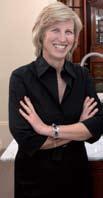


Autumn in Nyc
Central Park
Broadway bridge
Historical shop in Soho

East Broadway Avenue

Banksy-rat-graffiti

Lovely Restaurant in East Village

Pre-War Bld. in Greene Street
People outside Apple store

Columbus Circle from TWC

‘The Lake’ in Central Park

Nyc Subway (Park place)
Interior made by Rusk Renovation

49
03 06 10 05 04 07 11 11 08 09 12 01
02
03
04
05
06
07
08
09
10
11
12
13
t ws m — #3.10 13
Work cities New York City
showed that we rate 4.5 stars out of 5 for quality, but only 3.5 stars out of 5 for cost. We found that our clients were concerned about the financial health of the organizations that they considering doing business with, and we have been careful to maintain profitability. Our Dunn and Bradstreet rating also rates us in the 98th percentile for paying subcontractors. This gave us the ability to get preferential treatment and pricing from the best subcontractors in New York”
4 MIRANDA MAGAGNINI [icestone.biz], the creator of IceStone, focuses on the triple bottom line by maintaining concern for people, planet, and profits. The IceStone product, which is made from 100% recycled glass and cement, provides a highly durable concrete surface. These slabs are cut, and installed just as if they were mined stone. IceStone is used for countertops, bathroom vanities, conference tables, and reception areas. In short, anywhere you would use mined stone. Miranda says,“We make slabs in 29 colors: our palette consists of neutrals, earth tones and vibrant high design colors.” IceStone has been installed across the country. Miranda says her success is due to the fact that “everyone at IceStone works together to help us achieve our goals. We work hard and have fun. Personally, I am driven to create a work environment that people want to be a part of, where their voices are heard. We have a collaborative work environment. Perseverance is our mantra”.
5 Forster PR is a small public relations firm specialized in the promotion of business books. MARk FORTIER [fortierpr.com] is the owner of this niche company, and works with many of the world’s bestselling and best-respected business authors and business thinkers. The question
that Mark suggests people consider is: Will there always be demand for your service or product, or is it something people might skip when budgets tighten? The answer, it seems, is that “Authors will always care strongly about the success of their book, and won’t skimp on this investment. More than most places in the world, New York is the center of many industries that thrive by having specialists of all kinds”. He suggests that people think of ways to offer a specialized service to a niche industry. “You can often find greater success the more focused you are”, he explains.
The recession has popularized outsourcing. This is a huge opportunity for small businesses to profit by offering services that were once done in-house. Mark is aware of the fragility of the market and consequently he suggests:“Look around to see where you find very high demand for something, aware that the better you know your customer and what they care most strongly about, the better chance you’ll have of succeeding in any business”.
6 JENNIFER C. LOFTUS [astronsolutions. com], is a founding partner of Astron Solutions, a Human Resource consulting firm headquartered in New York City. “We specialize in com-
pensation and total rewards consulting, employee surveys, and web-based talent management technology. We have over 250 clients in the USA. Approximately one-half of our clients are non-profit organizations”.
In her free time, Jennifer is an Adjunct Professor of Human Resources at Pace University, and is also President-Elect of HR/NY, the New York City Chapter of the Society for Human Resource Management (SHRM).


•
Jennifer’s success is based on a variety of factors
• Persistence
• Patience
• Determination
• Motivation to succeed
• Timing
• A love of learning
• Continual networking
• Not letting fear hold me back from experimenting or trying something new
• Effective time management
• A willingness to give freely without expecting an immediate benefit
• High energy
• A touch of divine intervention
t ws m — #3.10 51
By BAHAR PURALIGIL

The financial hub of Brazil
The balance of power in the world is shifting. We are witnessing a rapid rise of mid-size cities, while many others face relative decline.
Parag Khanna states that the middleincome countries are growing increasingly assertive. They are what we call ‘the emerging markets’. But don’t let the name mislead you. For, most of them have already emerged in many ways and have been attracting foreign investment in recent decades. This seems to be an ongoing situation where winners and losers are distinguished by collectives, such as individual cities and corporations rather than state by state.
Compared to large-scale destinations that have been exploited for years, it is now the turn of the middle size cities with their economic potential, business friendliness, human resources, cost of living, infrastructure and the quality of life they offer to their citizens.
SãO PAULO
Founded in 1554 by the Jesuits, São Paulo benefitted from the boom in coffee plantations and exports that followed from 1850 onwards—and to day is the commercial, financial and industrial locomotive of Brazil.
The largest city in Brazil, the Big Apple of Latin America, São Paulo is home to more than 20 million people within its metropolitan area. Growth covers almost everything from footwear to aerospace technology. Meanwhile the city dominates Brazil’s growing energy sector.
Thanks to the the city’s intense nightlife, the supply of excellent hotels and restaurants, good shopping malls, a busy calender of artistic/cul-
tural events and proximity to beautiful beaches heading towards Rio de Janeiro, São Paulo is the choice destination for ten million business and pleasure travelers every year.
Art is the soul of the city. The city owes its status as a world art capital to its 88 museums. These include the world-famous São Paulo Art Museum (MASP). There are also numerous venues for music, dance and theatre performances in addition to the International Arts Biennial and film festivals.
Av.Brasil
Though the mirrored skyscrapers with futuristic characteristics predominate the architecture of the city, it is possible to see the effects of several architectural trends such as the French art deco and art nouveau influence of the early 20th century as well as the modernist style of the 1930s, and even post-modernism.
What makes São Paulo Latin America’s most vibrant city is its multinational identity that makes it an amazing melting pot!
THE BUSINESS CAPITAL OF LATIN AMERICA
White collar workers living in Paulisto may
Having started The Work Cities Guide project with Turin in our November 2009 issue, we are now pleased to present the ´visitor´s manual´ to one of the most courteous cities in the world, the financial capital of Brazil; São Paulo. Besides the investment and business opportunities on offer, São Paulo is a magical city that will make you come up with excuses to stay for just one more day. Kuala Lumpur, the capital and the center for finance, insurance, real estate, media and art of Malaysia, will be the next stop of The Work Cities Guide in the July 2010 issue. Then, Denver, the city that is home to many major corporations in the central United States, and consequently a key trade point for the country, will be on focus of The Work Cities Guide in November 2010. Find out what these boom cities have to offer you, and enjoy The Work Cities Guide!
be locals or expats but they are all employed in multinational companies
t ws m — #3.10 52
cities São
Work
Paulo
THE WORk CITIES GUIDE IS NOW HEADING TO SãO PAULO, a Brazilian boom city. São Paulo is one of those cities that, in the foreseeable future, will dictate the direction of the world economy As a manual for business trips and foreign inhabitants, The Work Cities Guide series highlights these glittering cities of the 21st century.
Brazil Argentina Chile Peru Ecuador Colombia Venezuela
Suryname Uruguay Paraguay F. Guyane Bolivia São
Illustration by Eelco Van Den Berg, Rotterdam, NL
Guyana
Paolo
Hi Speedy Raoad
Parque Villa-lobos
Cidade Universitaria
Alto dei Pinheiros
Pinheiros
Jardim Paulista
GastaoAvenidaDoutor Vidigal
Lapa R. Aurelia Avenida Paulo VI
Bela
Vila Leopoldina R. Faustolo Barra Fundo Santa Cecilia Se
Bom Retiro Pari
Bras Belem
vista
Liberdade Mooca Cambuci Vila Mariana moema
Perdizes
Rio Pinheiros
in the sectors of banking, insurance, technology, communications, among others. Significantly, the city attracts the biggest and best-attended international trade fairs and congresses. As might be expected, the city boasts many hotels and restaurants of high standards, supported by vast numbers of highly-experienced servicesector professionals, in addition to a highly-efficient city transportation system. Hosting 90,000 events, São Paulo generates nearly 4 billion USD, and welcomes more than 10 million visitors.
ENTERTAINMENT
The city offers a nightlife full of oncein-a-lifetime experiences for those seeking fun. Over and above nightlife events, the vast array of theaters, plays, classical concerts, ballet recitals and latest Broadway productions provide excellent occasions for socialiazing with colleagues, or just to clear your head after a big meeting! São Paulo also has five amusement and theme parks just outside the city.
SPORT
São Paulo offers you all you are looking for in any price range. While some athletes enjoy the warm sunny days in public parks and playing fields, some busy over-time workers may visit the gyms, fitness centers and pool halls, when they leave the office. Alternatively, plan to watch the Formula 1 Grand Prix or the São Silvestre Marathon, which attracts athletes from 20 countries. As Brazil’s largest city gets ready to host the World Cup in 2014, some $43 billion is being spent on infrastructure projects.
EATING OUT
With 12,500 restaurants it is possible to appreciate worldwide food specialities. Do not, though, miss the chance to taste Brazilian cuisine. One thing is certain in São Paulo: you can order a different dish every day of the year. The Jardins district is the right spot to enjoy fine food in glamorous restaurants. For a more modest choice, the upbeat cantinas in Bela Vista or in the Public Market can offer you quick and satisfying menus alongside the courteous service for which São Paulo is world-renowned.
SHOPPING
São Paulo is a giant bazaar where you may purchase almost anything. For those addicted to window shopping, this pretty city is heaven on earth, especially during the holiday season. São Paulo is a spell-binding place where you feel you are visiting the whole world in just one location. Without a shadow of a doubt, you will be impressed and perhaps even a tiny bit intimidated by its spirit, but with so much to experience, there is little chance that you will not enjoy São Paulo. Or that you will not want to extend your stay by just one more day! •
t ws m — #3.10 53 [W
]
bienalsaopaulo.globo.com fifa.com gpbrasil.com masp.art.br mercadomunicipal.com.br saosilvestre.com.br
Work cities The greening of the cities
By FILIPPO DE BORTOLI
Getting the ‘green light’
The challenge of greening the economy has been taken very seriously by local governments, since this is one of most effective drivers for improving quality of life in large and mediumsized urban areas. Looking to some of the most interesting experiments, there’s a ‘green texture’ linking such diverse cities such as Melbourne, Stockholm, Hamburg, Amsterdam, Berlin, Tianjin, Singapore, as well as San José.
GREEN BUILDING CONFERENCE (SYDNEY, FEBRUARY 2010)
This year’s Conference took the title People, Places and Performance and, as always, explored new ideas in sustainable building, products and technologies all designed to make cities greener - and, consequentlymore attractive. Among the speakers was Malcolm Smith, an architect and founding Director of Integrated Urbanism at Arup UK. A few days later, and about 1,000 miles away, he was the guest speaker at the Leading Green Thinkers’ Breakfast in Brisbane.
It is perhaps no coincidence, that someone like Malcolm Smith - who has led the masterplanning of sustainable cities around the world, from Stratford (London, UK) to El Hassan (Jordan) and Pune (India) - was invited to speak in a country like Australia. It is also perhaps no coincidence, that the Green Building Conference should be held in Sydney, or that the Leading Green Thinkers’ Breakfast should take place in Brisbane. For Australia was possibly the first nation to play the ‘green factor’ as a key point in the November 2007 federal

elections. Focusing on renewables, as well as the Kyoto Protocol, and the need to strengthen the links between environmental safeguards and economic development, Kevin Rudd swept to victory. Having said this, we need to take account of the fact that, although a number of Australian cities score high in the international ‘quality of life’ rankings, European cities are also among the front-runners.
THE EUROPEAN GREEN CAPITAL AWARD

The European Commission has long recognised the fundamental role played by local authorities in improving the environment. The European Green Capital Award was conceived to promote and reward these efforts, to showcase and encourage exchange of best practice among European cities.

Competing for the award were cities that are signatories of the “Covenant of Mayors”, by means of which they have committed to go beyond the objectives of EU energy policy in terms of reducing CO2 emissions through
01 Ferns into the greenhouse, Planten un Blomen Park in Hamburg.
© Michael Pasdzior
02 Gåshaga, housing aimed at combining the comforts of contemporary urban living with a traditional archipelago setting in Lidingö near Stockholm.
© sandellsandberg
 LOOkING GREEN, THINkING GREEN, SHAPING GREEN CITIES, AND LIVING GREEN SEEM TO BE THE CONTEMPORARY ‘MUST DO’ THINGS Green thinking really can bring positive change in cities worldwide. Local administrations are leading the way. They know that improving quality of life brings benefits.
LOOkING GREEN, THINkING GREEN, SHAPING GREEN CITIES, AND LIVING GREEN SEEM TO BE THE CONTEMPORARY ‘MUST DO’ THINGS Green thinking really can bring positive change in cities worldwide. Local administrations are leading the way. They know that improving quality of life brings benefits.
55 t ws m — #3.10
[W
sanjoseca.gov] 01 02
arup.com ec.europa.eu erantis.com go-green.ae greencities.org.au
03
03 Bronze in the garden, Planten un Blomen Park in Hamburg.
© Michael Pasdzior
enhanced energy efficiency as well as cleaner energy production and use. Stockholm, the capital of Sweden is the first European Green Capital, with Hamburg taking over the title in 2011. Indeed, Northern Europe is showing what can be achieved by local administrations, alongside daily practice by residents who have willingly changed their personal lifestyles and personal behaviours in regards to food, water, mobility, energy consumption, and use of green areas.
GREEN
LIFE
ExPOSITION
IN MILAN (FEB 5-MARCH 28 2010)
With its theme being Building Sustainable Cities this exhibition showcases more than 60 examples of urban planning: single buildings and blocks that are changing and reshaping many European cities.
As explained by Maria Berrini, one of the exhibition curators, the exhibition shows what was done in specific areas of a particular town or city, these areas sometimes being redundant industrial estates. Elsewhere, disused railway stations or abandoned farmland, have been pressed into service for offices, or residential and commercial use.

In all cases, energy consumption has been reduced thanks to architectural innovation and building with “green” and special materials. Among other innovations: public transportation helps reduce pollution and green public areas are made available. Early-day outcomes are encouraging: in Amsterdam, 38% of journeys are conducted by bike (thanks to 400 kilometres of cycle-paths). In Freiburg, 70% of waste is recycled. Berlin has created an industrial district that produces 40% of all the solar cells used in Germany.
On the other hand, even if the Copenaghen conference in December 2009 did not produce significant effects for world greening, an initial positive effort has come from China, where something started to move in the right direction.
TIANJIN (CHINA) AND SINGAPORE
The most important experiment is probably at Tianjin, 150 kilometres from Beijing, where the so-called ‘Go Green Initiative’ is a 15-year Eco City project. The idea is to give some 350,000 residents a new green urban environment, setting ambitious

04 Morning exercise in the heartlands, Singapore.

© Lim Lian Hai
05 Modern buildings in Tianjin

Economic Technological Development Area Tianjin China
06 Museum Tianjin
07 Labrador Park, Singapore.
© Singapore Tourism Board
04 05 06 07
56
Work cities The greening of the cities

(but maybe too ambitious) goals regarding air quality, carbon emissions, green building and public transportation.
It is surely not by chance that this project derived from a joint effort between China and Singapore. For the City-State is one of the best examples in the Asian region, where a ‘Garden City’ becomes a ‘City in the Garden’. What looks to be mere wordplay is, in fact, the challenge that Singapore is aiming to win in the next couple of years. Nature and technological innovation will come together in an urban environment, where eco-sustainability moves from a project to a reality.
The new plans - called ‘Gardens by the Bay’ - impact one square kilometre in the heart of the city, on the waterfront, costing 500 million euro.
SAN JOSé, CALIFORNIA
One of the most innovative projects in the USA is the ‘carrot and stick’ approach adopted by the City Council of San José, in California.
Keyed on three main targets - clean technology, sustainability and green mobility - the capital of Silicon Valley has, since October 2007, adopted a ‘Green Vision’. The objective is to transform San José into a world centre of Clean Technology innovation. A fifteen-year plan, consisting of clear rules and incentives has been set in place. Preliminary results can be seen at www.sanjoseca.gov/greenvision/ VisibleStrategies.asp. There is also an active platform designed to introduce real change in people’s personal behaviours.
This kind of approach demonstrates that economic growth, environmental stewardship and fiscal responsibility can drive the city into a new era, creating some 25,000 new ‘clean tech’ jobs. Much more importantly, though, it calls for an unprecedented alliance between local authorities, citizens, business companies, schools and universities. Working together, they are jointly responsible for a thoroughgoing change in political and civil culture.
The challenge is for new generations of architects, designers and for a new breed of professional trained in skills that were simply inconceivable just ten years ago. And these kinds of people have much greater ‘green’ expectations than their parents did. They are looking for ‘smaller’ situations, where global connectivity intersects local quality of life, creating a (new) social identity. In this way, they will be giving their own personal contribution to build the ‘personality’ of the city of tomorrow. •
08 Mosebacke torg at Södermalm in Stockholm. ©Nicho Södling
09 Singapore Botanic Gardens. © Singapore Tourism Board

10 Brandeburg Gate fountain in Berlin. © Lehnartz GbR Lehnartz, Klaus und Dirk
11 Stockholm: a nice walk along Djurgårdskanalen in the end of summer. © Nicho Södling


57 t ws m — #3.10
11 08
09
10
Moving Polluted cities
By SACHIN JOSHI
IS

The cost of doing business
When it comes to deciding on the location of a plant or an office, executives typically consider a combination of business opportunities, tax advantage corporate structures, and low costs, including the cost of environmental regulation. All of which is quite normal! In many countries one would also look at the possibility of bypassing such regulation. This helps further reduce costs.
EASY SOLUTIONS
The willingness on the part of the governments of most countries to trade-off environmental protection against economic growth is facilitating the export of ecological problems from the developed countries to the developing countries. The former have mostly already cleaned up their contaminated places because they have strong anti-pollution laws and most of those industries moved to developing countries. But in many developing countries the cost of life in the politician’s mind is much lower than in the developed world.
The rate of growth of hazardous industries in developing countries is now greater than overall industrial growth in those same countries. This indicates that the cost advantages stemming from weaker environmental protection do indeed attract greater investment.
CAUSES OF THE GROWTH OF POLLUTION


These industries are typically concentrated in, or around, urban centres. They also have the tendency to accelerate economic activities in the periphery, leading to rapid urbanisation in the area. In combination, this triggers the pollution time-bomb. The number of polluted cities has increased more rapidly in the last thirty years than at any other time in history. Problems of polluted cities increase with growing population and im-
CLEAN-UP COSTS
Some of the worst-polluted sites involve lead battery recycling, which takes place in many urban centres in developing countries. Cleanup costs can range from $10 million for sites that involve polluted rivers, to $20,000 for cleaning up rusty containers of toxic chemicals that face the risk of exploding. Degrading the environment is one impact, but in what causes societal change, there is also a business disadvantage to unsustainable development, which in turn also leads to an unhealthy and a poor quality of life.
provements in material consumption across the world. Typically viewed to be a cause of concern to governments, it is increasingly an issue for business through impending cleanup or relocation costs, lawsuits, not to mention an unhealthy workforce. Executives often do not make decisions about the location of plants, head offices and so on based on comprehensive ‘quality of life’ indicators and environmental impacts. They tend to make decisions based on economic numbers that defy healthy living and clean environment.
PROBLEMS AND CONSEQUENCES
Polluted cities pose health threats to people, including cancer risks to adults and learning disability risks in children. Asthma and other respiratory ailments are other problems suffered by millions of people living close to sites such as metal mines in Africa and China, and factories that make industrial chemicals in former Soviet Union states and India. An unhealthy workforce means loss of productivity, high medical bills, reduction in operational efficiency, higher employee turnover, and higher costs of replacing employees.
58 t ws m — #3.10
THE PROBLEM
BECOMING CONSTANTLY MORE URGENT, not just for governments, but for businesses as well. Sachin Joshi, Deputy Director of the CII-ITC Centre of Excellence for Sustainable Development in New Delhi (India), gives us an idea of how companies can benefit from an active contribution to a less polluted site and city.
Illustrations by Reynaldo L. Vásquez, Caracas, Venezuela
Major Sources Health Effects Environmental Effects
So2 Industry Respiratory and Precursor to acid rain, cardiovascular illness which damages lakes, rivers and trees, damage to cultural relics
No x Vehicules Respiratory and Nitrogen deposition leading industry cardiovascular illness to over fertilization and eutrophication
PM Vehicules Particles penetrate deep Visibility industry into lungs and can enter bloodstream
CO Vehicules
Headaches and fatigue, especially in people with weak cardiovascular health
Lead Vehicules Accumulates in bloodstream over (gasoline) time, damages nervous system Fish and animal kills Ozone Formed from Respiratory illness Reduce crop production reaction of NO x and forest growth, smog and VOCs precursor
VOCs Vehicules, Eye and skin irritation, nausea, industrial proc. head haches, carcinogens Smog precursor
SMART LONG TERM SOLUTIONS
At the other end of the spectrum, it is also in the interests of large businesses not just to undo damage, but also to work with people and municipalities to rebuild cities to make them sustainable. That is a smart long-term investment, as against a short-term cost benefit.
Some of the largest global and regional corporations are working
European seas
•Sea-level rise
Arctic
Impacts of Europe’s changing climate - 2008 indicator-based assessment by EEA (European Environment Agency)
Major Sources, Health and Enviromental Effects of Air Pollution by WRI (World Resources Institute)
•Decrease in Arctic sea ice coverage
•Greenland ice sheet loss
Northern Europe boreal region
•Less snow, lake and river ice cover
•Higher sea surface temperatures
•Northward movement of species
•Increase in phytoplankton biomass
•Higher risk for fish stocks
North-western Europe maritime climate
•Increase in winter precipitation
•Increase in river flow
•Northward movement of freshwater species
•Higher risk of coastal flooding
with governments to come up with standards and performance requirements because they lend some consistency and reduce risks. Businesses also need to take note of the growing number of major cities that are developing sustainable development plans. It is a very simple transition for the policies of the city’s sustainability programmes to be pushed upon the businesses operating within the city.
If a business already has a sustainable development plan, it won’t need to scramble when a government passes more stringent legislation. It will already have a competitive advantage when it comes to the environment and will, therefore, be in a better position to increase profits. •
Mountain areas
•High temperature increase
•Less glacier mass
•Less mountain permafrost
•Higher risk of rock falls
•Increased river flows
•Higher forest growth
•Higher crop yields
•Northward movement of species
•More energy by hydropower
•Lower energy consumption for heating
•More (summer) tourism
•Higher risk of damages by winter storms
Central and eastern Europe
•More temperature extremes
•Less summer precipitation
•More river floods in winter
•Higher water temperature
•Higher crop yield variability
•Increased forest fire danger
•Lower forest stability
•Upwards shift of plants and animals
•Less ski tourism in winter
•Higher soil erosion risk
•High risk of species extinction
Mediterranean region
•Decrease in annual precipitation
•Decrease in annual river flow
•More forest fires
•Lower crop yields
•Increasing water demand for agriculture
•Higher risk for desertification
•Less energy by hydropower
•More deaths from heat waves
•More vector-borne diseases

•Less summer tourism
•Higher risk of biodiversity loss
t ws m — #3.10 59
[W earthtrends.wri.org eea.europa.eu]
Green locations Furniture: not sitting down on the job
OFFICE FURNITURE INDUSTRY HAS SUFFERED AS A RESULT OF THE ECONOMIC CRISIS. During a downturn, companies concentrate on “saving money”, cutting back on new office furniture, ignoring the fact that such investment accounts for just 1% of company costs.

Simplicity & sustainability
The global economic situation is creating difficulties all round. What are the prospects for the office furniture industry?
MARkET SITUATION
Claudio Feltrin, CEO of Arper (Italy) is brave-hearted, and tells us “we are fighting back. We are still going to develop our product range, support the brand and expand our distribution network. Not least of our innovations in 2010 is that, in collaboration with the Lievore, Altherr, Molina design studio, we are launching a new modular seating system, dubbed Team”.
As Export Director of Guialmi, a leading Portuguese office furniture manufacturer, Jorge Almeida is responsible for his company’s sales and marketing strategy in all foreign markets. He reminds us that “office furniture is considered a commodity. Thus, in many crisis situations, this becomes one of the “costs” that companies cut more quickly and without much reflection”. The office furniture market is going through hard times. Lucia Arioli, Marketing Manager at Methis, says “Only companies that produce the best quality and best-designed fur-
niture at very competitive prices will survive”. Roman Przbylski, a member of the board at the BoardNowy Styl Group, thinks the same. He says “we are seeing price wars, margins are
narrowing, companies are running to overcapacity. This will lead to major changes in the market. Some companies will disappear, while mergers and takeovers are to be expected. Companies that have reacted quickly and decisively, adjusting their business models and cost structures, will be the winners”. Chakrit Vorachacreyanan, Executive Vice President at Rockwork, proposes a macro-economic analysis to explain the situation in Thailand: “both the decrease in productivity and the increase in daily wage contributed to a 7.6 percent increase in unit labor costs in manufacturing during the third quarter much higher than the 4 percent increase over the last four quarters and the 0.3 percent rate from 2000 to 2007. Unit labor costs increased 3.1 percent in durable goods industries and 14.3 percent in nondurable goods industries during the third quarter”.
Alexander Schärer, CEO at USM U. Schär-
er Söhne AG, is optimistic. “The sector is getting a lot of support from the economy,” he explains, “which has a positive effect on our industry”. Burkhard Remmers, Director
of Interna-
tional Communication at Wilkhahn, shares the same view: during the crisis his company has launched ON, “an office chair boasting first-class design that sets a new standard in ergonomics with its three-dimensional dynamic seating concept. ON has attracted enormous attention, and is in huge demand worldwide”
OFFICE FURNITURE DESIGN TRENDS 2010



Office furniture must fulfill two requirements. It needs to be comfortable, on the one hand, and look appealing, on the other.
Burkhard Remmers says “There are basically two trends: standard office furnishing concepts with a uniform style that are designed to be low on cost. The second trend consists of highly customised concepts that offer stimulating working environments with varied, high-quality design concepts”. “In general, the trend aims at a keenly-priced, comfortable and,
60 t ws m — #3.10
THE
01 02 03
04
By MILAN LEE
01 The Landessparkasse zu Oldenburg Project by Wilkhahn
02 Cubiko, designed by Ivan Palmini for Babini Office
03 Eircom Project 2009 by Guialmi
04 Office Project by Rockworth

05 USM Modular Furniture Haller and Kitos Table Private loft, NY (USA)

06 An office equipped with Arper. © Gionata xerra
07 Office Project by Nowy Styl Group
“Scientific research has demonstrated that people work better if their work environment is pleasant. They are more productive, and take less sick leave, all of which provides an important saving of money for the company in the long term”.
Monica Babini Managing Director Babini Office.
since many people stay in work place for considerable amounts of time, a visually pleasing style,” Claudio Feltrini says. Monica Babini argues that “the crisis has changed the way people
set up so that people could surf the net when away from home”. Lucia Arioli echoes this view and states that “there will be tailor-made offices very close to the domestic way of living”.
08 Program A1700, trolley by Thonet 05 06 07

think. Now esthetic aspects are no longer enough to clinch a sale”. “Fortunately, there’s still plenty of good will towards classic, timeless, office furniture, such as USM“ says Alexander Schärer. Jorge Almeida follows, in essence, with a global analysis. “Europe is mainly contemporary fashion wise. So is the Middle East, albeit with a more conservative approach to design and aesthetics. Africa is more traditional, and America is looking at design and aesthetics more than before”.
Chakrit Vorachacreyanan says “We realize that a successful organization requires harmonious integration between people, equipment and technology. IBM has opened an office in full force free engineering in Thailand. Many of the Fortune 500 companies have hot desks and touch-down areas where people can connect to laptops and have face-to-face meetings, as and when required. The initial idea has evolved from cyber cafés that were
ENVIRONMENTAL AWARENESS
European companies have problems addressing competition from the Far East. Companies selling products in Europe should adhere to the same level of requirements as European manufacturing companies. However the influence of sustainability is widespread. Among interior designers and architects the number of LEED accredited professionals has grown from less than 2,500 in 2005 to nearly 40,000 today. Over one thousand commercial and residential projects have been LEED certified, and nearly 8,000 more have been registered. “Looking for ‘green’ and ‘clean’ products coming from “efficient” and also ‘green’ factories has become part of the buyer’s task, at least when we are speaking of public or governmental companies and multinationals”, says Jorge Almeida.
According to Claudio Feltrin “a certain awareness of the importance of

08
environmental sensibility and sustainability is already present in the contract sector. Interest in the subject is also based on the general normative requirements in the contract sector”. Roman Przybylski, Board Member at Nowy Styl Group, adds “environmental awareness is becoming more and more important...due to general education awareness of environmental issues, higher pressure on the companies’s social responsability policies and also because economic factors”. Philipp Thonet states that “most companies are aware of their responsibility and are taking environmental matters into consideration when it comes to furnishing their offices. This is why eco-friendly furniture becomes increasingly important”. Burkhard Remmers says “there are virtually no major calls for tender in international markets where customers do not ask about the ecological performance of the products and manufacturing companies”.
[W arper.com guialmi.pt methis.com nowystylgroup.com rockworth.com usm.com wilkhahn.com babini.com thonet.com]

t ws m — #3.10
61 •
Green locations The stylish workplace
By FABIAN UzARAGA
IN A BYGONE AGE, VIRTUE WAS TO BE ExPRESSED THROUGH EARNEST ExERTION THAT MASTERED NATURE WHILE. More recently, happiness was derived from the material possessions that a career provided. In a globe where the environment no longer seems limitless, meaning will be increasingly sought in workplaces that are genuinely committed to corporate social responsibility.


Aesthetics and happiness
In The Pleasures and Sorrows of Work (2009), Alain de Botton tells us that, in Aristotle’s time, happiness was to be found in not having to work, since “financial need placed one on a par with slaves and animals”. However, the industrial revolution changed all that with bourgeois factory owners extolling productive labour as the embodiment of virtue by their workers. In his Architecture of Happiness (2006), de Botton remarks that engineering knowledge in the industrial age could declare “a structure was correct and honest in so far as it performed its mechanical functions efficiently; and false and immoral in so far as it was burdened with nonsupporting pillars, decorative statues, frescos or carvings”.
As the austere classical liberals gave way to the Keynesians in the mid-20th century, the lure of work became increasingly tied to the consumerist materialism afforded through gainful employment. Thus, the growing range of mod-cons and more leisure-time in the home were mirrored, in the Modernist (and increasingly feminized) office space, with clear markers of career advancement, including quality furniture, the latest office technologies, and stylish decor, in addition to enclosed offices for professional experts and managerial aspirants.
The need to create materially bountiful workplaces came to the fore, however, when economic circumstances were buoyant and companies competed for workers. During the current global downturn, according to de Botton, “it is most important that employees have a feeling of involvement, being in control, making positive differences, job security and a sense of management and com-
knowledge work equals four work models © Gensler 2008 Workplace Survey United Kingdom
pany direction. Fear and boredom”, he warns, “are the two great enemies of the happy worker”.
What about the 21st century when manufacturing is now subcontracted to China, and direct marketing, back-office administration, and after-sales customer-care continue to be off-shored to India? According to Richard Florida in The Flight of the Creative Class (2005) “the (new) terms of competition revolve around a central axis: a nation’s ability to mobilize, attract, and retain human creative talent”. This same competition for scarce innovative flair, it seems, will drive efforts among individual firms in creating alluring offices, labs and studios.
Thus, in its 2008 Workplace Survey for the UK, Gensler, a global design and architectural firm, found that there was a positive link between the top financially performing companies it assessed and the quality of their attributes such as lighting, airflow, furniture comfort, layout functionality and acoustics for sustainable, ergonomically sound and flexible working. More importantly,






Gensler’s survey found that top performing companies were those that designed four distinct modes into their day-to-day workspaces.
While the first, ‘focus’—distraction free, protected time to get individual work done—was important, Gensler found that purposeful integration of the other three modes, ‘collaboration’, ‘learning’ and ‘socializing’, were common linking characteristics of the most successful firms. Furthermore, the study found positive relationships between profit and revenue growth, employee engagement and strong corporate brands to well-designed workplaces. Richard Watson in Future Files: A Brief History of the Next 50 Years (2008) notes that information technologies, will not only continue to blur distinctions between working ‘inside’ and ‘outside’ an organisation, ‘home-time’ and ‘worktime’, or between ‘social’ and ‘professional’ relationships. Socializing and heightened levels of employee engagement also resonate with Daniel Pink’s argument in A Whole New Mind (2006) “that the era of ‘left brain’ dominance, and the Information Age that it engendered, are giving way to a new world in which ‘right brain’ qualities - inventiveness, empathy, meaning - predominate”. Finally, in coming full-circle, it might be knowledge workers seeking more meaningful work lives who will condition the need for employers to be more virtuous and socially responsible in a globe facing the challenges of environmental, demographic and wealth imbalances.
Effective worplace design directly correlates to better business performace © Gensler 2008 Workplace Survey United Kingdom











•



t ws m — #3.10 [W alaindebotton.com gensler.com]
63
Joining the company Head Hunters seek ‘enthusiastic multi-specialists’
AN ECONOMIC CRISIS IS A SIGN OF FAILURE FOR HUMAN CAPITAL, whether in the public or private sectors. In order to resolve the crisis, and start a new cycle of growth and economic development, human capital needs to be renewed. A key role of HR consultants is to help their client companies identify this new human capital.
Managers’ attiditudes
HR Directors worldwide have experienced an extraordinarily difficult period because of the economic crisis, according to Philip Crenigan, director of De Jager & Associates, North Sydney (Australia), especially in terms of “compromises that were made in terms of strategy. Employees are disappointed because long-term investment has failed for them”.
During this recent crisis, few companies have shared their problems with their employees. Those who did, though, were able to create a culture of collaboration and creative solutions. In the market, according to one survey by Philip Crenigan “some 76% of candidates are, actively or passively, trying to change their role”. However, in difficult times, candidates may not necessarily be motivated to leave their current employers. The top candidates who are performing well in
their current organizations may not wish to subject themselves to unnecessary risk in changing jobs. Indeed, more often than not, the incentive to change jobs is driven by “push” factors from the existing employer, rather than a “pull” from the prospective employer.
WHICH PROFILES ARE ATTRACTIVE Alfredo José Assumpção, CEO and founding partner of Fesa Global Recruiters of São Paulo, Rio and Curitiba (Brazil), adds that “an executive must be willing to work anywhere around the globe, and has to have an optimum service attitude”.
Paul Lien is Partner, Senior Consultant and Branch Office Manager of the PCI Executive Search Consultants in Beijing, China. He explains the needs in his country, “as a con-
Developing Leadership skills in four key areas by Simon Ashley 10.2009
Individual Development
Self Leadership Skills
Sel Motivation Self Awareness Emotional Intelligence
General Skills & Knowledge General Business Knowledge Communication Skills Time Management Team Management Presentation Skills Knowledge of Business Law
People focus Task focus
Group Leadership Skills Awareness of Others Inspiring and Motivating Others Managing Relationships
Business Leadership Skills Organisational Awareness Managing Change Managing Complexity
Organisational Development
sequence of the downturn, the Government has invested heavily in new infrastructure,including Power, Energy, and Transportation. This to maintain the high GDP of recent years”. Therefore, almost all the global players related to infrastructure have rushed to start operations in China. The positions most often sought for these companies include: CEO, CFO, GM Country, as well as people to handle Government Relations. Supply Chain Management is another growth area.
Lim Chye Lian, global chairman of IIC Partners in Singapore, told us that, “although the global economic climate remains precarious, since the beginning of this year, we have seen steady demand for leadership positions, particularly in the Life Sciences and Industrial sectors, the latter covering industries such as chemical and automation products. Such positions tend to be for business leadership, and include CEO, Managing Director, or Business Unit Heads. Also being sought are Commercial leadership roles with major responsibility for revenue generation”.
WHAT DO CANDIDATES WANT Candidates are more demanding than ever about the company, the background, the role and why it is required, as well as how the CEO and future colleagues collaborate. What they, rightly, demand from the Client—and therefore the Search consultant—is honesty, transparency, swift feedback, clarity on the next steps in the process, in addition to absolute confidentiality. Clients sometimes forget that they are in a search process
All the interviewees are members of IIC Partner Executive Search Worldwide.
t ws m — #3.10 64
PD
and that the way they behave forms part of the candidate’s decision-making process. By behaving in ways that candidates find unacceptable, clients can become an issue. According to Alfredo José Assumpção, dates are looking for a place where they can be whole (completely used and served), where they have freedom to act, where they are used entirely, where they can put in use their know-
tants are “continually challenged by our clients to become as diverse and globally-minded as they have been. No longer is it enough for our firm to simply attract talent. Our clients now expect us to future-track talent and provide insight into how the organization may be received as it enters its new markets. Charlotte Eblinger adds, “One thing, however, applies to all clients: they want to find new staff who already have experience in the field in question. This might be a particular skill or expertise. But it could also be management experience, specialized customer contacts and the like”.

kEY ELEMENTS OF TODAY’S LEADER

Charlotte Eblinger invites all candienergy, drive and a positive attitude. Commitment, motivation and dedication are also absolutely essential” in the new challenge.
A guideline if you want to become a leader
1. Take controlled risk and shows courage in driving change
2. Communicate values and create a positive climate, empowering others and releasing their energies, individually and collectively

3. Show transparency in communication and actions
4. Show strong organizational, prioritization and planning skills
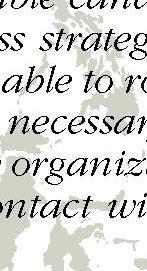

5. Show humility
in preparation for future positions. Organizations unwilling or unable to provide this opportunity and challenge internally cannot attract and retain the best talent”.

COMPANIES WANT CONSULTANTS


Charlotte Eblinger, CEO and founding partner of Eblinger & Partner Personal und Managementberatungs GmbH, Vienna (Austria), referring to her country, says, “our clients tend not to select candidates based solely on a first interview with the executive search consultant, a candidate profile, reference checks and a personal interview. They generally also want to run personality analyses and assessment centres.
According to Jeffrey Harris, consul-


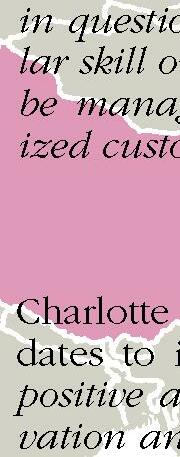
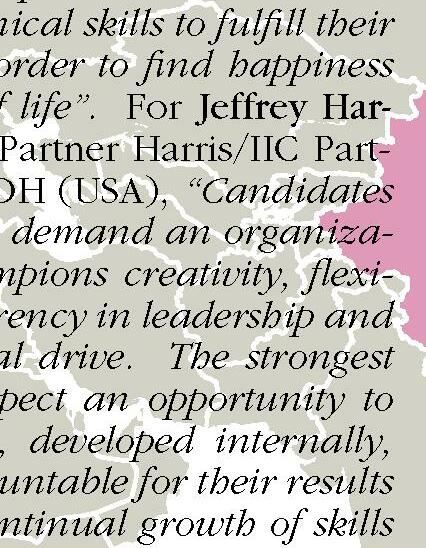
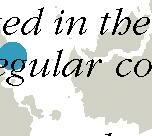







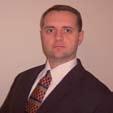
Lim Chye Lian adds, “Suitable candidates, must not only possess strategic prowess. They must also be able to roll up their sleeves, whenever necessary, to be closely engaged in the organization, and be in regular contact with their customers.




Their responsiveness to the unpredictable changes in the market place has to be precise and quick. Their ability to manage diverse stakeholders’ impatience for results and answers must be nimble and relevant”. •
6. Have strong financial planning skills
7. Have the ability to optimize workforce (both performance and behavior)

8. Have a strategic vision, direction, and leadership
9. Be a creative problem solver
10. Be an entrepreneurial leader who embraces the mission/objectives of the company

t ws m — #3.10 65 [W iicpartners.com]
Alfredo Assumpcao Brasil l
Jeff Harris USA
Paul Po-Ping Lien China
Phil Crenigan Australia
Lim Chye Lian Singapore
Charlotte Eblinger Austria
BY IIC Partners an Executive Search Worldwide. IIC Partners has 49 offices in 35 countries, providing global reach, local savvy and industry expertise. IIC Partners search professionals and know the difference between a glowing resumé and a brilliant career: “We bring you a world of talent”.






Movers and shakers































Mauricio Montilho has been the Chief Financial Officer of Sky Brasil Serviços Ltda, since April 2009. Sky Brasil Serviços Ltda provides direct broadcast satellite (DBS) TV services to more than 800,000 residents in Brazil. With over twenty years of professional experience, Mauricio Montilho started his career at Unilever Brazil, one of the ‘Big 4’. He worked in the consumer goods sector for Unilever Brazil (São Paulo/ SP) and Elma Chips (Pepsico Brazil). He participated in a start up and went to Philips as VP & CFO (Chief Financial Officer), before moving into the retail sector. He has been CFO of Astrazeneca Brazil, São Paulo/SP; VP Financial Planning & Analysis for Wal Mart International (Bentonville/AR) and VP & CFO Philips Oral Healthcare (Seattle/WA) He has consolidated his professional experience mainly in multinational companies.
Cliff Wu has been the Greater China Managing Director of Fair, Isaac and Company, since December 2009. The company is the pre-eminent provider of creative analytics that unlock value for people, businesses and industries, Fair, Isaac and Company’s predictive modeling, decision analysis, intelligence management and decision engine systems power more than 14 billion decisions a year.
Founded in 1956, Fair, Isaac helps thousands of companies in over 60 countries acquire customers more efficiently, increase customer value, reduce risk and credit losses, lower operating expenses and enter new markets more profitably. Cliff Wu has more than 25 years working experience within the IT industry with strong leadership and proven business management track records with Unisys, AT&T, NCR, and Teradata (Greater China GM).
Tom Bai is the President of EuroChina Dredging Company. After nine years working for the largest domestic Petrochemical Group –Beijing Yanshan Petrochemical as Executive manager, and seven years serving for Siemens China in various senior management positions (Sales Director-China), he joined IHC Dredging
Technology Co., Ltd as the Country General manager at the start of 2008. He was offered the position of President of EuroChina Dredging Company at the end of 2009.

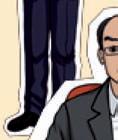
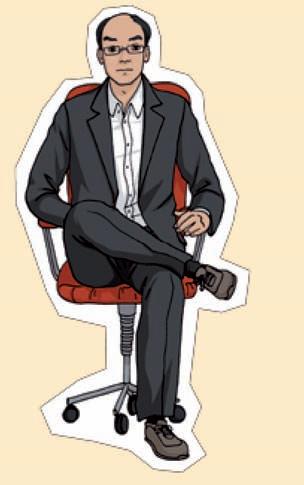


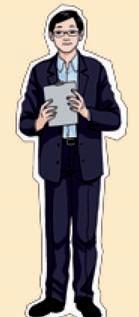

EuroChina Dredging Company is majority-owned by BlueCrest Capital Management LLP, a UK-based Venture Capital with a Chinese Partner. A Hong Kong based entity, it is concerned with delivering environmentallyfriendly fresh water dredging services to the Chinese market.
Douglas Peterson is Vice President and General Manager of Phoenix Contact GmbH & Co., Blomberg, Germany, which operates 46 international subsidiaries. Douglas Peterson joins Phoenix Contact after 19 years at GE Fanuc Automation, where he held a variety of sales and leadership positions, both in the field and at the company’s headquarters in Charlottesville, VA. Most recently, he served as vice president of sales for GE Fanuc Intelligent Platforms. In that position, he led global sales for the $500 million embedded board manufacturing business, overseeing all aspects of sales operations and channel management in the Americas, Europe and Asia. Prior to this, he was vice president of the company’s CNC business. Douglas Peterson holds a bachelor’s degree in Electrical Engineering from the University of Dayton and an MBA from xavier University in Cincinnati.
66 t ws m — #3.10 Appointments
Global overview
APPOINTMENTS
Illustrations by Giulio Macaione, Bologna, Italy
PD
Sanjay Dudaney has been named CEO of Halcyon Solutions International. He brings over 20 years experience in management and information technology consulting services to the business. He has most recently worked with companies such as Accenture, Price Waterhouse, Covansys and Nationwide Insurance in the areas of strategic planning,
Matthias Grundböck

Ryan Helon has accepted the position of Vice President and Chief Financial Officer at CBI Global, Inc. Ryan Helon’s career spans nearly 15 years and includes leadership roles in corporate finance, strategy and private equity, primarily in the financial services, information technology and chemical industries. Prior to joining CBI Global, Ryan spent ten years at Nationwide in roles of increasing responsibility, including six years as the founder and Managing Director of Nationwide Mutual Capital, the strategic private equity division of Nationwide. In this role, he led a team that completed over 20 new and follow-on investments and successfully exited several investments. Ryan Helon earned a Bachelor’s Degree in Finance and Economics and received an MBA with concentrations in Finance and Strategy from The Ohio State University Fisher College of Business.
As Director of Marketing and Sales, Matthias Grundböck has headed up Tiscover AG‘s travel portal and Destination Marketing unit since April 2009. As Managing Director, he is head of the business units: “Portal”, “Destination Management Systems”, “Contracting”, “Customer Service” and “Corporate Marketing and PR. After graduating in International Business Sciences from the Universities of Innsbruck and Maastricht, he joined Plaut Austria as a management consultant. He then moved into Marketing at the Telekom Austria Group, where he held various management positions across the group, including heading up Private Customer Marketing at the mobile communication firm Vipnet in zagreb, Croatia and Business Marketing at Telekom Austria in Vienna.
process reengineering, operational excellence, sales and marketing, software development, program management and technology development. During his tenure at Covansys, he directed a consulting practice expansion strategy that successfully penetrated new markets, including private sector funds and federal and international retirement systems. He also managed the Public Sector Software Development Center, a CMM certified facility that employed over 120 software developers and managers, and serviced 19 clients nationwide. He earned an Electrical Engineering degree from National Institute of Technology, India and an MBA from the Indian Institute of Management.
Michael kühling is Chief Executive Office of the medical technology company EMCOOLS. The Mechanical Engineering graduate with a post-graduate qualification in Business Economics and Law had already gained 16 years experience in various management roles in the international medical technology sector prior to joining EMCOOLS. He began his career in 1994 as a Product Manager (with BBRAUN Cardio-Medical GmbH, Berlin) and was promoted to Marketing & Sales Manager
in 1996 (with BBRAUN Austria GmbH, Maria Enzersdorf) to handle sales of new product lines in Austria. In 1999, he moved to a privately financed medical technology start-up (Inflow Dynamics AG, Munich) as Chief Technical Officer, where he played a decisive role in the company’s successful acquisition by world market leader Boston Scientific Corporation, USA in 2004. In 2008, he was appointed Managing Director of a privately owned, mediumsized German medical technology company. During his time with this firm, he restructured the distributor sales network in EMEA and Asia, initiated sales activities in India and China and launched an OEM project for Canada.










Paolo Ruozzo is the new CEO of Guaber Italy, a company of the Spotless Group. He has more than twenty years experience in sales and marketing, both in Italy and elsewhere, in top-name Italian and multinational FMCG companies. With a degree in Business Administration from Bocconi University, in 1990 he joined Unilever as brand Manager in Italy and then moved to Unilever Belgium Marketing Manager, where he stayed until 1994. Returning to Unilever Italy, he acquired considerable experience until 1997. In that year, Paolo Ruozzo moved to The Coca-Cola Company as Channel manager for both on- and off-premises business. From 1999 to 2001 he was Innovation Director and, from 2001 until 2003, he held the post of Operational Director. In 2003 he joined Averna Italy, an alcoholic drinks business as General Director.
as sales •






















































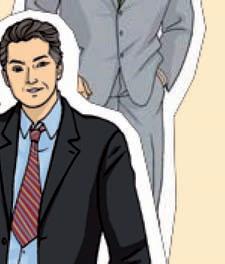









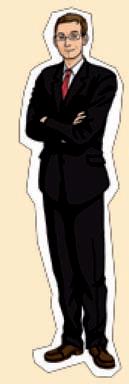







t ws m — #3.10 67 [W iicpartners.com]
To be cool Design ideas
iF International product design award 2010



iF is considered a reputable and stable brand and is especially known for its design awards. iF has offices in Taipei, Munich, Seoul and Paraná. The iF Product Design Award is one of the world’s oldest, best-known design competitions. The international jury of experts bestowed an iF Product Design Award on 778 competition entries out of 2,486 entries this year. All winners received an iF Seal of Design Excellence, which remains valid for the entire product lifecycle. The 2010 installment represents the 56th edition of the iF Product Design Award. [W ifdesign.de]
iF gold award
Slim Office Office table and accessories from Arco Contemporary Furniture Winterswijk, Netherlands.
Designer Bertjan Pot Schiedam, Netherlands. [W arcomeubel.nl]
Salida net Office swivel chair meshback from Samas, Germany.

Designer Daniel Figueroa Worms, Germany. [W samas-buero.de]
Stabilo EASYergo 1.4 Ergonomic mechanical pencil from Stabilo International Nürnberg, Germany. Designer Boris Simon München, Germany. [W stabilo.com]
Textmarker 5 Düller Highlighter / pen from Idea International, Tokyo, Japan.

Designer Naori Miyazaki Tokyo, Japan. [W idea-in.com]
Mono zero Pinpoint eraser from Tombow Pencil, Tokyo, Japan. Designer Chisato Takahashi Tokyo, Japan. [W tombow.com]

t ws m — #3.10 72
To be cool Fashion in the world The Business side of style
Rosenheim, São Paulo and New York City
A young stylist has worked for the “To Be Cool” column:
Demetra Dossi, a revelation of Milan Fashion Week 2010. Demetra is a 21 year old law student and blogger who launched a fashion website pigchic.com. Demetra is the young solution to old fashioned journalists who are perhaps too know-it-all and orientated towards powerful fashion salons to interact with the young.
I imagine you already know what I’m talking about.
This column adopts a specific approach which moves away from customs and habits. The work style magazine wants to dress managers according to the taste of the new world.



t ws m — #3.10 73
Photo credits • Lutz Duerichen, Germany • Charles Beckwith, USA • Claudio Edinger, Brazil
Rosenheim German Axel knapp
São Paolo Brasil Ana Claudia Fatia New York USA Simon Hammerstein
Managing Director and Europe Sales Director of Laird Technologies, he lives in South/Southern Bavaria near Lake Chiemsee (the largest lake of Bavaria, Germany). Axel believes in the importance of spending quality time with his family and always tries to dedicate the limited free time he has with his wife, 14-year-old son, and 8-year-old daughter. He likes to go skiing in winter time and mountain biking with his wife or friends all year round, weather permitting.

[W mart.trento.it]
Axel knapp
Advice from Demetra Dossi for the’Axel Style’. For Axel, given his passion for sports and adventure, I chose a sporty look. I selected clothes and accessories perfect for a trip around the snowcapped mountains like the Napapijiri’s coat and Fischer’s cross-country ski, and suitable clothing for a stroll in a park such as Puma shoes. To complete the look I chose the new Ray Ban carbon fiber sunglasses and a great keychain by Dsquared.
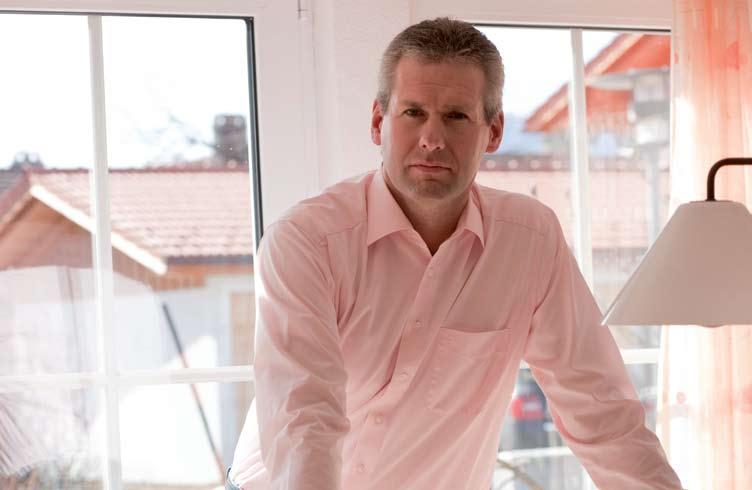

01 Ray Ban Sunglasess RB 8303 (159 ¤). 02 Puma Easy Rider III Wash (90 ¤). 03 Napapijri coat (139 ¤). 04 Fred Perry sweatshirt (146 ¤). 05 Fisher Fibre Crown (165 ¤). 06 Dsquared 2 Key Case.
04




02 01 06
05 03
75
During summer he also loves to spend time on the shores of the Chiemsee Lake. Gardening is Axel’s greatest passion other than his job. He finds working on the home garden with his wife relaxing: the perfect way to unwind even though he thinks the garden surrounding his house will never be finished due to the new ideas they always come up with on how to rebuild sections of the garden. He believes that every man and woman is the architect of their own destiny. Axel says “do not wait until something happens in your life” and adds that this may sound like a cliché but is true in every way.



Simon is President of The Box, a dinner theatre on New York City’s Lower East Side that has revived the tradition of variety theatre that had been lost for nearly a century. Over the past nine years he has helped produce, direct, and manage several shows each season at New York City theaters such as The Maverick Theater, The Flea, and Soho Rep.
Growing up in Soho as a member of one of New York’s esteemed theatrical families, Simon was exposed to show business at an early age by his father, a Broadway director himself. Never one to follow a traditional path Simon, without his parent’s permission, left a prestigious boarding school in upstate New York to return to Manhattan to follow his theatrical dreams. Working his way up through the ranks, Simon became a member of the Actors’ Studio Writers & Directors Unit and the Lincoln Center Director’s Lab, holding the position to this day.
 Simon Hammerstein
Simon Hammerstein
His recent productions include the world premieres of Matt Pepper’s St. Crispin’s Day, Adam Rapp’s Trueblinka, The Passion of George W. Bush, and revivals of Jean Paul Sartre’s Men Without Shadows and Eugene O’Neill’s Moon of the Caribees. His work has also been presented by Joe’s Pub, Ensemble Studio Theater, La MaMa, Gloucester Stage Co., and others.
Simon dedicates most of his time to his two passions: rock-climbing and running his successful dinner theater, the Box, making sure the venue is a unique and exciting part of the New York City nightlife.

Advice from Demetra Dossi for the ‘Simon Style’. For Simon, I selected a look inspired by the country-chic style and I chose simple and comfortable clothes to wear in multiple occasions, perfect for the spring. I chose items which play with shape, colors and materials. For example, I proposed a Fred Perry blue cardigan and a pair of brown leather sneakers by Puma. I devoted much attention to details and I selected elegant and particular accessories like the Enrico Coveri’s purple and yellow bag and the Havana Glitter Super Sunglasses.



03



02

05 01
01 Puma MY 49L (170 ¤). 02 Havana Glitter by Super Sunglasses (127 ¤). 03 Allure Homme Blanche by Chanel EDT 100 ml (76 ¤). 04 Brioni jacket. 05 Fred Perry cardigan (146 ¤). 06 Enrico Coveri bag. 04 06 81
Ana Claudia Fatia




Ana Claudia was born in the city of Bauru (São Paulo) on 19/11/1983. She began training for the Chinese martial art, kung fu wushu, when she was 17, with no intention to become a pro wrestler, that she is
now, at 26 years of age. She has won the Brazilian Championship four times, the South America Championship and PanAmerican Championship once. She took third place in a World Cup in China. She also gained two bronze medals for the World Cup in Sanshou.

06 02 01 05
(name of a typical Wushu combat style, also known as Chinese boxing).


She has a degree in Physical Education. She teaches wushu to people to demonstrate the true meaning of martial arts. For, kung fu is also a philosophy of life, which means “good job” and can be applied to everything you do in your life. She believes that this principle leads her to success in the ring. She is careful about her physical and psychological training. To get prepared for fights, she usually uses her full potential to its highest limits. Everytime she wins she is even more convinced that it is worth it. Ana Claudia devotes her life to kung fu and also she finds time to play with her pets, two dogs and two chinchilla. She enjoys also travelling. She likes making new friends and visiting new places. Besides being a professional fighter, Ana Claudia Fatia is proud of her looks, and loves to stress her femininity.

03 04
01 Fred
(97 ¤). 02 Fred
03 Puma
04 Puma
(140
05 T-shirt
06 Dsquared2
(675 ¤).
Advice from Demetra Dossi for the ‘Ana Claudia Style’. I selected sporty, colorful and feminine clothing in keeping with her style. I chose clothes and accessories with strong colors such as red and blue. I opted for colorful sneakers, a pair for sport and the other pair to use every day, an elegant striped shirt, two polos top with fun pins.
Perry Shirt
Perry Polo (86 ¤).
MY 48L (140 ¤).
MY-1 Reborn
¤).
Adidas Originals (24 ¤).
bag
Shutter Island 03

What Came Before He Shot Her by Elisabeth George
My purple iPod Lufthansa
Corynthia Nevsky Palace Hotel (St. Petersburg, Russia)
La Nef des Fous (Lyon 5ème, France)
A pair of skis 06

An Education 04

Shame by Salman Rushdie
My white MacBook 08 Lufthansa

Hotel Yastrebetz, Borovetz Ski Resort (Bulgaria)
Belga Queen, Brussels (Belgium) and Chef’s Restaurant, Bulgaria
To be cool Our choices
Le Concert by Radu Mihaileanu 01

Letters to Lucilio by Seneca
Spheres and balls in general Air France
San Pietro Positano (Salerno, Italy)
Relais Blu, Massa Lubrense (Naples, Italy) 11


Kung Fu Panda 02

The War of the End of the World by Mario Vargas Llosa
BlackBerry StormTM 9550 Singapore Airlines
Oriental Mandarin (Bangkok, Thailand) 09
Ristorante Gallura (Rome, Italy)
Gevrey-Chambertin, Clos Prieur 2006

A day at the wonderful ski resort of Les Contamines Montjoie (Haute Savoie, France)
A secretly planned long weekend in Barcelona Santa Sara Privat 2006 A day spent in Marrakech, breathing in the aroma of spices on the street market, having the best orange juice on the street, and secretly trying to take the best photo
A Damiani ring from the Maji Collection 07
Taurasi Mastroberardino Centotrenta 1999 05
Sailing across Greek islands in the Ionian Sea 10

Jewelry: BVLGARI band ring in 18kt gold with 0.04 ct diamond

Prosecco A villa on the beachside in Kota Kinabalu, Sabah (Malaysia) with a golf course nearby
in Sofia (Bulgaria),
* for one’s spouse or significant “other”
We have asked Sophie Desjardin — editor in chief at Euronews in Lyon (France), Daniela Dimitrova — a BMW manager
Riccardo Imperiali — heir of one of the oldest and most aristocratic families, in Naples (Italy) and Antonio Corbi — a lawyer and entrepreneur in Kuala Lumpur (Malaysia) to select ‘our choices’.
Movie Book
Airline Hotel Dinner Gift* Wine Vacation 85 t ws m — #3.10 06 08 07 09 10 11 01 02 03 04 05
Object
Book selection Exciting New Releases
Interviews
• Dan Roam, The Back of the Napkin
• Louis E.V. Nevaer, Managing Hispanic and Latino Employees
• Richard Donkin, The Future of Work
• George Cloutier, Profits Aren’t Everything, They’re the Only Thing
• Shaunti Feldhahn, The Male Factor
Books
• The Practice of Adaptive Leadership, Ronald Heifetz, Alexander Grashow and Marty Linsky
• The Lean Machine, Dantar P. Oosterwal
• Leadership the Barack Obama Way, Shel Leanne
• The Trainer’s Tool kit, Second Edition, Cy Charney and Kathy Conway
• The Power of Business Process Improvement, Susan Page
• How the Best Leaders Lead, Brian Tracy
• The zero Turnover Sales Force, Doug McLeod
• What’s Next, Gen x?, Tamara Erickson
• Leadership and Self Deception: Getting Out of the Box 2nd Edition, The Arbinger Institute
• The Manager’s Guide to Maximizing Employee Potential, William J. Rothwell
t ws m — #3.10
88
Book Twsm selection
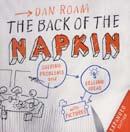 By PAOLA BETTINELLI
By PAOLA BETTINELLI
The Back of the Napkin
twsm Is there a link between state of mind and drawing ability?
dr Yes, but there shouldn’t be. Everybody can draw. The problem is that so few of us believe that we can. The biggest challenge in helping businesspeople understand the power of pictures is convincing them that they can draw. I often ask them to remember how they learned and communicated back in Kindergarten. The answer is always, “I drew simple pictures”. If you could do it then, why not now? As humans, we are fundamentally and innately visual. Threequarters of the sensory neurons in our brain are focused on vision. In other words, the first thing we learn is how to look at the world around us, and understand how to visually navigate through it. Everything else we can do follows from that first step. Being able to see the world with the clarity of Leonardo is a rare talent. But being able to sketch out a few circles and lines to communicate an idea is as common as walking.
twsm What is the upside of using figures during the process of brainstorming? How does it increase information storage?

dr First, drawing during the brainstorming process is mandatory. When we think with a pen in our hand, our brain
is much more free to discover connections between ideas because it doesn’t have to remember everything. On the contrary, when we can see the components of our evolving idea directly in front of us, we’re infinitely more likely to discover hidden connections than if we just talked about it. Second, drawing simple human figures makes the process even more powerful, because our brains are extraordinarily well developed to recognize faces and the human form. We are simply hard-wired to see more detail and deduce meaning from the human form than anything else.
twsm You talk about about drawing and planning; would you identify yourself as an artist, or a strategist or both?

dr As a child, I drew all the time. Therefore most adults said I was an ‘artist’. I didn’t believe them because in my mind I wasn’t doing anything unusual. In University, I studied hard science (biology) and creative art (painting). While there was nobody in my painting class in my biology class, and vice-versa, I still believed there was more in common between the two disciplines that there was different. As I moved into management consulting, I know for a fact it was my continuing to make simple drawings of the ideas I heard in meetings that made me successful. Because people could literally see what I was thinking about, they were more willing to be open and participate directly in the development of the idea. That’s when the best strategy work happened: when people forgot their fears of being misunderstood and instead found ways to see what each other’s ideas really were.
twsm What would you advise to those managers who are gifted strategists
bad artists?
dr Practice. I often ask people if they
just making up those jokes right then on stage, or if a great actor like Meryl Streep is making up her character as the camera roles. Of course not. While these people have innate talent, it is practice that makes them great. The same is true for those of us wishing to harness the power of visual problem solving. It’s simple: stop only talking about everything
twsm How one can improve his sketching skills?
dr Find an approach that you are comfortable with. I offer several simple frameworks and tools in my books, and I know from experience that many people find them a useful starting point for improving their visual thinking skills. But again, the most important thing is to try.
Dan is the founder of Digital Roam Inc., a management consulting company that helps business executives solve complex problems through visual thinking.
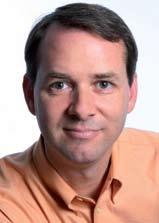 Dan Roam, author of The Back of the Napkin [W thebackofthenapkin.com]
but
think a comedian like Jerry Seinfeld is
Consultant and lecturer Dan Roam argues that everyone is born with a talent for visual thinking, even those who depend mainly on their left-brain analytical skills. Used properly, a humble napkin is more powerful than Excel or Powerpoint. It can help you crystallize ideas, think outside the box, and communicate more powerfully than any traditional business presentation. His bestseller The Back of the Napkin, will help readers, literally see the world in a new way.
and instead start drawing it out.
Dan Roam, author of The Back of the Napkin [W thebackofthenapkin.com]
but
think a comedian like Jerry Seinfeld is
Consultant and lecturer Dan Roam argues that everyone is born with a talent for visual thinking, even those who depend mainly on their left-brain analytical skills. Used properly, a humble napkin is more powerful than Excel or Powerpoint. It can help you crystallize ideas, think outside the box, and communicate more powerfully than any traditional business presentation. His bestseller The Back of the Napkin, will help readers, literally see the world in a new way.
and instead start drawing it out.
89
•
Managing Hispanic and Latino Employees
Hispanics are the largest minority group and the fastest growing demographic in the United States—they are already 15 percent of the population and 22 percent of the workforce, and it’s estimated that by 2050 those numbers will go up to 36 percent and 55 percent. In Managing Hispanic and Latino Employees?, Nevaer helps non-Hispanic employers and colleagues understand how Hispanics see the business world—and the world in general—so they can better support and develop this dynamic group of workers.
twsm Does a book which talks about managing Hispanic and Latin American employees entail the fact that there are differences compared to managing employees from the rest of the world?
If yes, what are these differences?
ln This book differentiates between Hispanics and Non-Hispanics in the US labor market. It also discusses a subset of Hispanics, which are Latin Americans. Only Hispanics, who number more than 35 million, have reached a tipping point in the US labor market to require a dedicated analysis of the cultural, historical and social differences that differentiate them from the mainstream American majority, which is Anglo-Protestant in its sensibilities and worldviews.
twsm How do South Americans view the job market?
ln South Americans comprise about two percent of all Hispanics in the USA, not a significant group. They consider themselves ignored, and confront obstacles to becoming permanent residents in the USA unless they are married to a US citizen.
twsm How do South Americans view the world in general?
ln This question cannot be answered adequately in 500 characters, but suffice it to say that South Americans, as a general rule, feel ignored and marginalized on the world stage. With the exception of the emerging powerhouse of Brazil, the rest of Latin America is not considered to be of consequence by either Europe, Asia or the USA, and South Americans feel the sting of this indifference.
twsm How does your work integrate with the wish to “be all equal” in the job Market?




ln There is a difference between being equal before the law, and how human beings interact. This book is a guidebook to help non-Hispanic managers understand the radical transformation changing the American workforce as a result of the ascendance of Hispanics in the USA. It is, in many ways, the destiny of the USA, in the course of this century, to become a Latin American country simply because of demographics. How do nonHispanic Americans begin to come to terms with the fact that they fast on their way to becoming a minority, and how can they, in the workplace, prepare to train, cultivate and nurture a Hispanic identity, one that mirrors the reality of the demographics in the United States?
The Future of Work
Changing attitudes, living patterns and technologies are transforming our relationship with work in such fundamental ways that tomorrow’s workplace will be barely recognizable to parents. To help us make sense of these changes, Richard Donkin has examined the forces and themes that are influencing what amounts to a silent revolution in social behavior.
He is director of Hispanic Economics, which analyzes Hispanic consumer behavior.

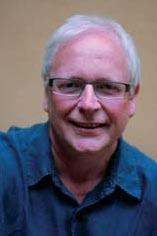
twsm Technology is blurring the line between spare time and work time. How does this latest generation link influence our life?
rd The blurring of demarcations in occupations that utilise modern communications allows people to move seamlessly between work and leisure. This means that employers should recognise people for the results of their work instead of clockwatching employees through their tasks. Employers must learn how to set fair expectations and to be satisfied when these are fulfilled or exceeded. This approach, however, demands strong levels of trust and a detailed understanding among employers of work inputs. They need to respect and reward good work.
Book Twsm selection 90 t ws m — #3.10
Richard Donkin author of The Future of Work [W richarddonkin.com]
Richard Donkin is a Financial Times columnist and writer on management and employment issues.
Louis E. V. Nevaer author of Managing Hispanic and Latino Employees [W hispaniceconomics.com]
•
Book Twsm selection
twsm How do timeliness and our living online affect the quality of our remarks and the coherence of the projects developed by the companies nowadays?
rd A generation of young people who have known the internet all their lives are entering the workforce for the first time. One of their strongest features is the way they use the internet for collaboration and the way they will happily break the rules established for a different kind of society. Naturally, traditional society would like to bend this generation to its established style of working. This is a source of generational tension. Winning employers will be those who learn how best to harness this urge to collaborate in project work.
twsm Distance work has been defined a very positive fact by many observers. How do you consider its role in a present reality where everyone and everything is connected?
rd Home working has many benefits for employees. It removes the expense and wasted time in travelling to work and helps people to organise their days more efficiently. For employers, it removes the costly overheads of providing workspace. Management resistance to this kind of working is based on a lack of trust and lack of control. There is also a natural fear for the job. If people do not need to be managed, where is the role of management?
In reality, the role is in setting reasonable expectations, communicating, organising and ensuring that employers remain socialised with their employer and, where necessary, with each other. Social needs should not be overlooked, but they are often over-exaggerated by opponents to home-working.
twsm Imagine the average worker in ten years time ...
Our selection
Ronald Heifetz, Alexander Grashow and Marty Linsky, The Practice of Adaptive Leadership Tools and Tactics for Changing Your Organization and the World, Harvard Business Press 304 pp. ¤ 18.99
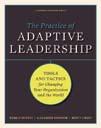
The rules of the game have changed and the goal is to survive and thrive in a future where the future is unknown. With uncertainty and turbulence as the norm, a new kind of leadership is called for, where the most essential skill for any leader is the capacity to adapt, to meet unanticipated new realities, and prepare for unknown futures. Adaptive leadership is the practice of mobilizing people to tackle tough challenges and thrive under the most difficult circumstances. The Practice of Adaptive Leadership: Tools and Tactics for Changing Your Organization and the World by Ronald Heifetz, Alexander Grashow, and Marty Linsky will help people and organizations nurture change and growth under challenging circumstances rather than perish, regress, or contract.
he joined ‘The Motor Company’, as it is known to insiders, the dark days of Harley-Davidson’s bankruptcy were a distant memory. Yet he was impressed to still find executives who not only rode Harleys to work in jeans and boots, but also bonded with customers at motorcycle rallies, and was amazed to find that his colleagues truly followed the credo of Values, Issues, Stakeholders instilled during the turnaround years. Opening a fascinating window into Harley-Davidson’s success, The Lean Machine shows how any company can consistently excel at developing innovative and profitable products—and keep employees motivated, energized, and always learning.
Shel Leanne, Leadership the Barack Obama Way, McGrawHill 274 pp. $ 24,95

rd I would be reluctant to describe such a person at all, because the average worker is likely to be a woman, certainly in some western economies such as the US and the UK where, proportionately, the number of women in the labour market is very close to that of men and could cross over to the majority in that time frame. Women are demanding, and getting, greater flexibility at work, so we should expect more home working in future if that is most convenient for some.
Dantar P. Oosterwal, The Lean Machine, How Harley-Davidson Drove Top-line Growth and Profitability with Revolutionary Lean Product Development, Amacon 272 pp. $ 27.95
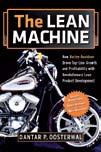
In this book, Oosterwal reveals the mindset and system behind the enduring success of the iconic maker of the great American motorcycle. By the time
This book is about the art of leadership, the power of persuasion, and the principles and techniques that have allowed Obama to attain such notable levels of leadership success. It distills the leadership best practices that Obama has honed over the years. Leaders in all fields—business, law, nonprofit, academia, policy making, politics—can benefit from the principles, practices and techniques that have enabled Obama to form effective visions, communicate his ideas, persuade people, form and lead outstanding teams, build bridges among diverse people, motivate the young, and implement innovative ideas with great effect. Leadership the Barack Obama Way examines the ins and outs of the leadership style the President of the United States rode to heights of power nobody dreamed possible just a short time ago.
•
t ws m — #3.10 91
Book Twsm selection
Profits Aren’t Everything

After hearing about his book, the first impression one gets is that Mr. Cloutier seems to be quite a presumptuous man. But as one reads on, one comes to discover fact that there are many rules you keep at heart.
twsm Interviewed George Cloutier to get a better understanding of his point of view.
gc American Management Services has worked with six thousand small businesses in over four hundred industries. The profit rules laid out in my book. Profits Aren’t Everything, They’re the Only Thing, are the result of my direct experience watching failures turned into successes and losses transformed into profits. My views are controversial, because I tell it ‘as it is’ and it conveys what most business owners sense, but are afraid to say. This book is not for those owners who enjoy financial mediocrity and failure.
twsm Does having strict rules and exercising a lot of control mean that one is ‘viewed in a bad way’ by one’s employees?
gc Having strong policies and procedures (strict rules) while exercising day to day control (micromanaging) does not mean that an owner will be viewed negatively. The implementation and the manner in which an owner delivers and enforces his/her rules will ultimately determine
whether they are loved, respected, disliked, etc. Poor performing and mediocre employees will always resist strong Profit Rules. There is no place for them in your business.
twsm What is the acceptable level of trust that a company must give to its employees? What does ‘trust’ mean in terms of business?
gc Every company must expect their employees to be honest in terms of basic legal and moral rules. The amount of trust an employee enjoys is determined by the employee’s record of performance on the job. You can relax oversight on employees who are performing to your expectations and work on other areas of compliance.
twsm What does control mean for you? How is control exercised in the corporate world?
gc Control can be subtle or straightforward. It means owners can set a direction and profit level for their business, while developing policies and procedures that are intended to be followed; not circumvented, ignored or constantly debated. Control means that you have implemented your policies and they are met by your employees. Control should be exercised fairly through a ‘carrot and stick’ method. Control should be established by compensation, and other tangible rewards, for those employees who want to rise above mediocrity.
twsm Is the employer a sovereign who must be respected by his own people or is he a General the army is willing to die for?
Cy Charney and kathy Conway, The Trainer’s Tool kit (Second Edition), Amacon 224 pp $18.95

The Trainer’s Tool kit: Second Edition has long been a valued guide for trainers and managers. The book is still the perfect resource for new trainers, managers who have been asked to train, and training professionals in need of a quick refresher. This new edition supplies instant guidance specifically designed to make any training task easier and more efficient. The book provides concise, easy-to-digest nuggets of information that readers can put to use even at a moment’s notice. The wealth of updated material includes expanded coverage of retention programs such as mentoring and career and succession planning. Taking a fresh look at a broad range of ideas, The Trainer’s Tool Kit shows how to achieve significant performance improvements through effective training
George Cloudier is chairman and founder of American Management Services, a management firm that specializes in turning around small and mid-sized businesses.
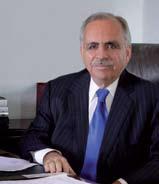
(Photo credit Lucien Capehart)
gc An owner should be a benign ruler and be respected for his/her role in leading the company to achieve serious profitability and its other objectives. I don’t believe it’s necessary that employees be willing to ‘die’ (go the last mile) for the company. Those who do should be significantly rewarded. Being loved is not necessary for an owner.
twsm What role does salary play in the relationship between employer and employee?
gc “Compensation isn’t everything, it’s the only thing”. Neither the owner (employer) nor the employees should be working at the company for a social experience. If you want to have a social cause, join a charity or other nonprofit company. Compensation in the relationship between the employer and the employee might not be everything, but it is way ahead of the next most important item. The more money an employee can make, generally the happier they and their family will be. Paying for performance is the biggest factor in why companies succeed. Not paying for performance is why they only achieve financial mediocrity or outright failure.
t ws m — #3.10 92
George Cloutier
[W amserv.com]
•
Susan Page, The Power of Business Process Improvement 10 Simple Steps to Increase Effectiveness, Efficiency, and Adaptability Amacom 338 pp. $ 32.95

In this book, cutting through theoretical and technical explanations, the author shows business managers how to do the work of process improvement themselves, with confidence, while engaging their employees in the process. The book provides a roadmap for readers through a step-by-step journey to successfully solving real business problems in real time. Page begins by clarifying the core objectives of every BPI effort: (1) Effectiveness: Does the process produce the desired results and meet the customer/client needs? (2) Efficiency: Does the process minimize the use of resources and eliminate bureaucracy?
(3) Adaptability: Is the process flexible changes in business realities and requirements? With The Power of Business Process Improvement to lead the way, business managers will have the power to help their business stay competitive and responsive to customers, as well as nimble and resilient.
Tracy stresses to every reader who takes his or her job seriously. He starts by providing a series of questions to help aspiring leaders gain greater clarity into who they are, and what they want to accomplish. “The better you know and understand yourself, the better decisions you will make, and the better results you will get”, Tracy states. In the author’s signature fast-moving, resultsfocused style, the book presents practical ideas and field-tested strategies that leaders and managers at every level can use immediately. Affirming that leaders are made, not born, Tracy shows how to think and act like a true—and truly exceptional—leader. Along with the utmost qualities of leadership (vision, courage, and integrity among them) and a critical course in self-knowledge.
Tamara Erickson, What’s Next, Gen x? Keeping Up, Moving Ahead, and Getting the Career You Want, Harvard Business Publication 256 pp. ¤ 14,99
Brian Tracy, How the Best Leaders Lead Proven Secrets to Getting the Most out of Yourself and Others, Amacom 256 pp. $ 24.95

Thanks to global competition, fastevolving technology, and our turbulent economy, it’s a challenging time for anyone tasked with leading any business, department, or team. Through his work with top executives, business owners, and entrepreneurs in the United States, Canada, Europe, and Asia, Brian Tracy has identified the very best of best practices for achieving astounding results in tough markets against tenacious competitors. “The most important contribution you can make to your company is to be a leader, accept responsibility for results, and dare to go forward”,
Doug McLeod, The zero Turnover Sales Force How to Maximize Revenue by Keeping Your Sales Team Intact, Amacom 256 pp. $ 24.95

In his trailblazing new book, Doug McLeod explains how the most expensive and damaging sales cost can be dramatically reduced, if not eliminated. Offering much more than a quick bottom-line fix, he presents a fresh mindset and specific strategies to help sales visionaries at every level achieve the ultimate goal: building an industry-leading sales force that stays together and wins together. Why can’t most companies retain productive salespeople for long periods of time? The biggest obstacle, as McLeod makes clear, is ‘Old School’ sales management practices. He exposes what’s wrong with the way most companies recruit, train, monitor, compensate, and motivate their sales staff—because that’s the way it’s always been done. Then, he lets sales executives and managers in on how to rev up their company’s revenues and revolutionize their own careers by daring to defy conventional sales business wisdom.
Members of Generation x, the 30-to-44 age cohort, have drawn the short straw when it comes to work. The economy has been stacked against them from the beginning. Worse, they’re sandwiched between Boomers (with their constant backpatting blather and refusal to retire) and Gen Ys (with their relentless confidence and demands for attention). Gen xs are stuck in the middle—of their lives and between two huge cohorts that dote on each other and that are taking up a little too much of xs’ room.
In What’s Next, Gen X? the author explains the forces affecting attitudes and behaviors in other generations— Traditionalists (born 1928-1945), Boomers (born 1946-1964), xs, and Ys (born 1980-1995)—so xs can start relating more productively with bosses, peers, and employees. Erickson then assesses Gen xs’ progress in life so far, and analyzes the implications of organizational and technological change for their professional future.
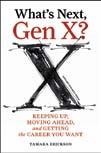
The Arbinger Institute, Leadership and Self Deception: Getting Out of the Box (2nd Edition), Berret –Koehler 216 pp. $ 16.95
Since its original publication nine years ago, Leadership and Self-Deception has become an international word-of-mouth phenomenon. The book’s central insight—that the key to leadership lies not in what we do, but in who we are—has proved to have powerful implications not only for organizational leadership but in readers’ personal lives as well. This new edition has been revised throughout to make the story more readable and
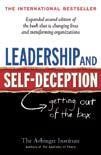
93 t ws m — #3.10
Book Twsm selection
The Male Factor
With her new book The Male Factor, Ms. Feldhahn reveals the hidden perceptions of men in the workplace, and their potential impact of women—the unspoken expectations that no man would dare to publicly acknowledge, and to which no HR department would ever admit.

compelling. And drawing on the extensive response the authors have received over the years, they have added a section that outlines the many ways that readers have been using Leadership and Self-Deception, focusing on five specific areas: hiring, team building, conflict resolution, accountability, and personal growth and development. Leadership and Self-Deception uses an entertaining story about an executive facing challenges at work, and at home, to expose the subtle psychological processes that conceal our true motivations and intentions from us and trap us, in a ‘box’ of endless self-justification—even when we’re convinced we’re doing the right thing.
William J. Rothwell, The Manager’s Guide to Maximizing Employee Potential, Quick and Easy Strategies to Develop Talent Every Day, Amacon 240 pp $17.95

Many books have been written about talent management and succession planning, but few have focused on how managers can incorporate the important task of finding, developing, and keeping the best people. The Manager’s Guide to Maximizing Employee Potential takes readers step-by-step through simple and effective strategies they can use to take talent management out of the HR department and place it in the hands of those truly responsible for their people—the managers. Aimed at managers at all levels and featuring real-world examples, this indispensable guide explains why managers, not the HR department, must take the lead in attracting, cultivating, and retaining the most productive, promotable people— and provides them with the practical skills they need to do it every day.
twsm If we could reprogram a male employee to make him the perfect coworker, what would he look like to his female peers?
sf Actually, there’s no need to reprogram a male or female employee, or figure out who is more at fault, because there’s nothing ‘wrong’ with either. We are just different. The one thing I would change, if I could snap my fingers and have it done, is to correct some of the misperceptions that men have about women (and vice versa, for that matter). For example, men tend to believe that if someone is ‘getting emotional’, they aren’t thinking clearly. Because of their multitasking brain structure, women – unlike men – actually have the ability to experience a relatively high degree of emotion and still process thoughts clearly at the same time.
twsm What are the most common misunderstandings among women? What don’t they understand?
sf Men view the work world as being so different that they think people shouldn’t even have the same feelings as they do in the personal world. That is almost automatic for men, because their brains naturally compartmentalize. They don’t realize that women are much more holistic in their viewpoints and mental patterns, and it is difficult, or impossible, to stop personal feelings from arising. Another thing women don’t realize is that they can unknowingly ‘hit a hidden nerve’ in a man that automatically triggers insecurity. For example, one hugely important thing for a man is to feel respected. They need to feel adequate, and they need to know they are respected and trusted by others. So even a minor comment that a woman perceives as harmless can stick in a guy’s head and cause him to feel disrespected and mistrusted. Another common misunderstanding is that women may not realize how ‘automatically visual’ men are, and how wearing that favorite lowcut blouse can actually undermine our career. Most of the time, we don’t do it on purpose; we’re trying to be stylish. My research shows that men are biologically hard-wired to notice those things, meaning they can’t not notice.
twsm What should men do, if anything, to be better understood by women?
sf The key is for men to realize that because the internal differences between men and women aren’t discussed, women may simply not know certain things, or be willing to talk about them. Therefore, it would benefit men to explain certain assumptions and thoughts and ask ‘are we on the same page, or are you thinking about this differently‘? What unwritten rules could we change to avoid misunderstandings between women and men in the workplace? Again, its not so much that any unwritten rules ‘should’ change, as much as simply KNOWING what those unwritten rules are for each gender.
twsm What advice would you give to a woman who wants to get along better with a male boss?
sf Although there are always exceptions, it is highly likely that most male bosses (like most men) fall into the categories discussed in the book, so the most important thing she should know is that he WILL have perceptions one way or another, and that it is up to HER to take control of how she is perceived rather than having her perception created for her.
Shaunti Feldhahn author of The Male Factor [W shaunti.com]
Shaunti Feldhahn is a bestselling author and speaker. She holds a master’s degree in public policy from Harvard University.
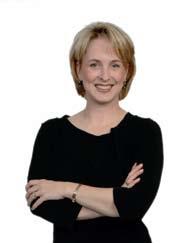
t ws m — #3.10 94
•






























































 By FRANCESCO MOCELLIN
By FRANCESCO MOCELLIN














 By GIORGIO TEDESCHI
By GIORGIO TEDESCHI















































 LOOkING GREEN, THINkING GREEN, SHAPING GREEN CITIES, AND LIVING GREEN SEEM TO BE THE CONTEMPORARY ‘MUST DO’ THINGS Green thinking really can bring positive change in cities worldwide. Local administrations are leading the way. They know that improving quality of life brings benefits.
LOOkING GREEN, THINkING GREEN, SHAPING GREEN CITIES, AND LIVING GREEN SEEM TO BE THE CONTEMPORARY ‘MUST DO’ THINGS Green thinking really can bring positive change in cities worldwide. Local administrations are leading the way. They know that improving quality of life brings benefits.


























































































 Simon Hammerstein
Simon Hammerstein



























 By PAOLA BETTINELLI
By PAOLA BETTINELLI


 Dan Roam, author of The Back of the Napkin [W thebackofthenapkin.com]
but
think a comedian like Jerry Seinfeld is
Consultant and lecturer Dan Roam argues that everyone is born with a talent for visual thinking, even those who depend mainly on their left-brain analytical skills. Used properly, a humble napkin is more powerful than Excel or Powerpoint. It can help you crystallize ideas, think outside the box, and communicate more powerfully than any traditional business presentation. His bestseller The Back of the Napkin, will help readers, literally see the world in a new way.
and instead start drawing it out.
Dan Roam, author of The Back of the Napkin [W thebackofthenapkin.com]
but
think a comedian like Jerry Seinfeld is
Consultant and lecturer Dan Roam argues that everyone is born with a talent for visual thinking, even those who depend mainly on their left-brain analytical skills. Used properly, a humble napkin is more powerful than Excel or Powerpoint. It can help you crystallize ideas, think outside the box, and communicate more powerfully than any traditional business presentation. His bestseller The Back of the Napkin, will help readers, literally see the world in a new way.
and instead start drawing it out.


















